Debby is featured in the Fourth quarter edition of the First Aid Foundation (Dec 2018)
Page 12.
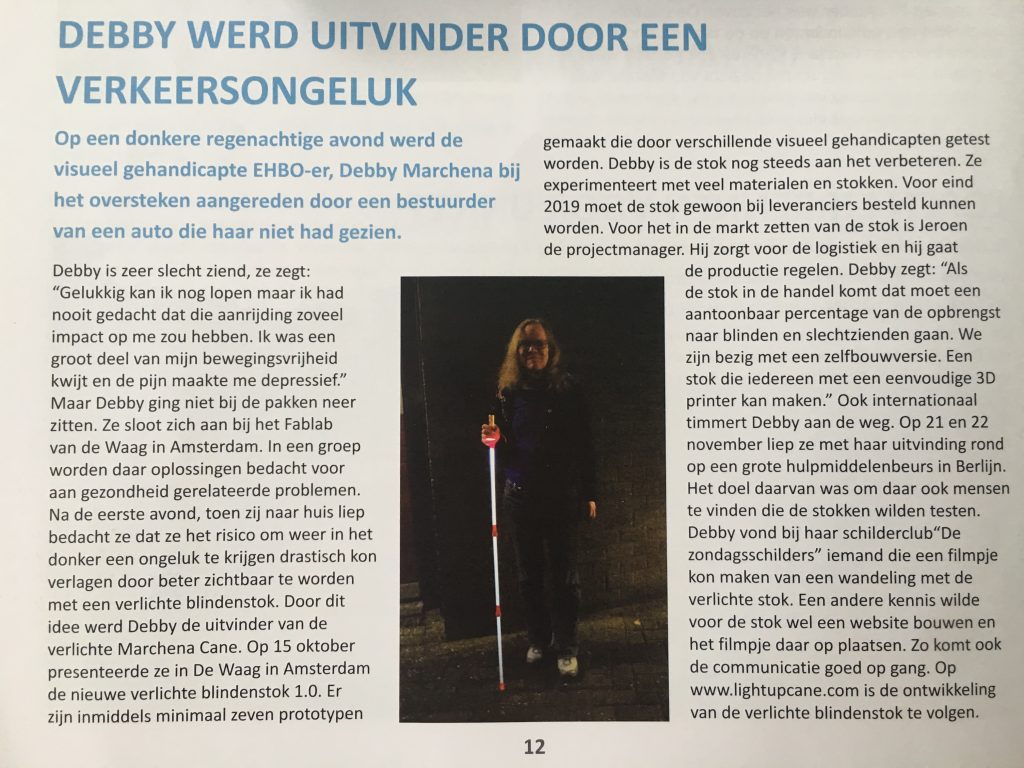
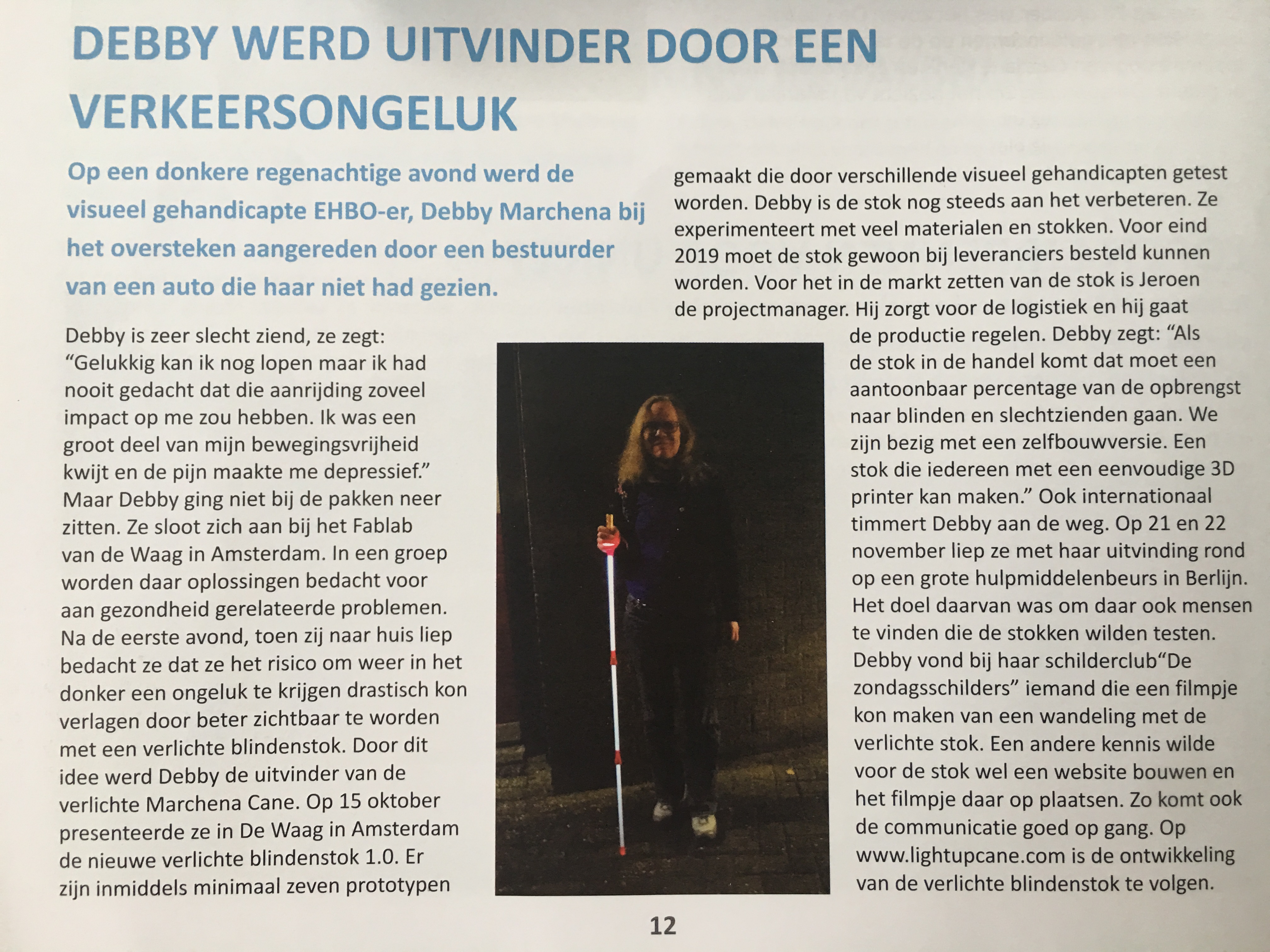
Mel Bohrmann observed Debby with her Lightup cane whilst walking and shared here exprecience on facebook. Just click on the picture and you can watch the Face book video
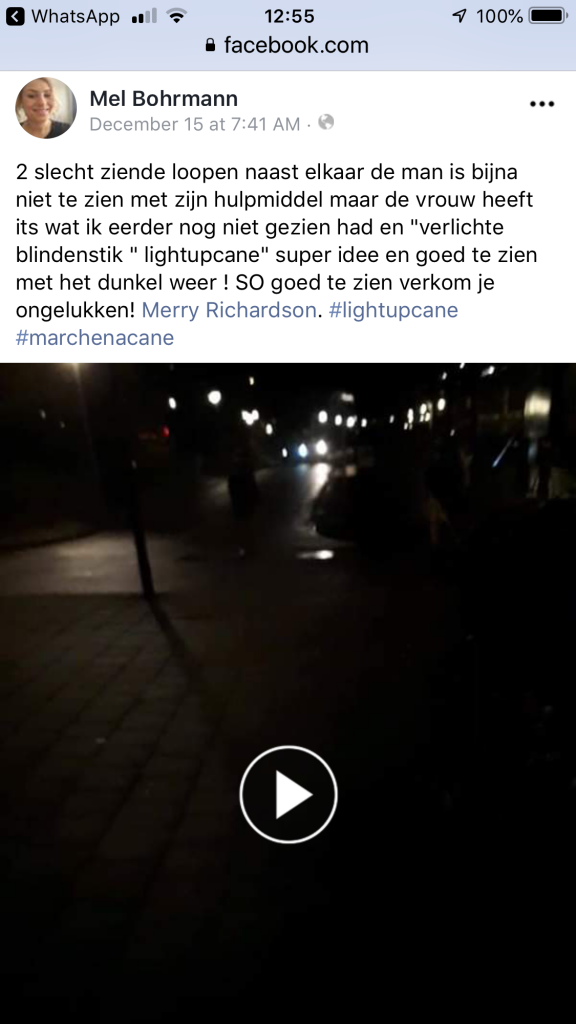
https://m.facebook.com/story.php?story_fbid=10214991448591978&id=1002188088&ref=content_filter
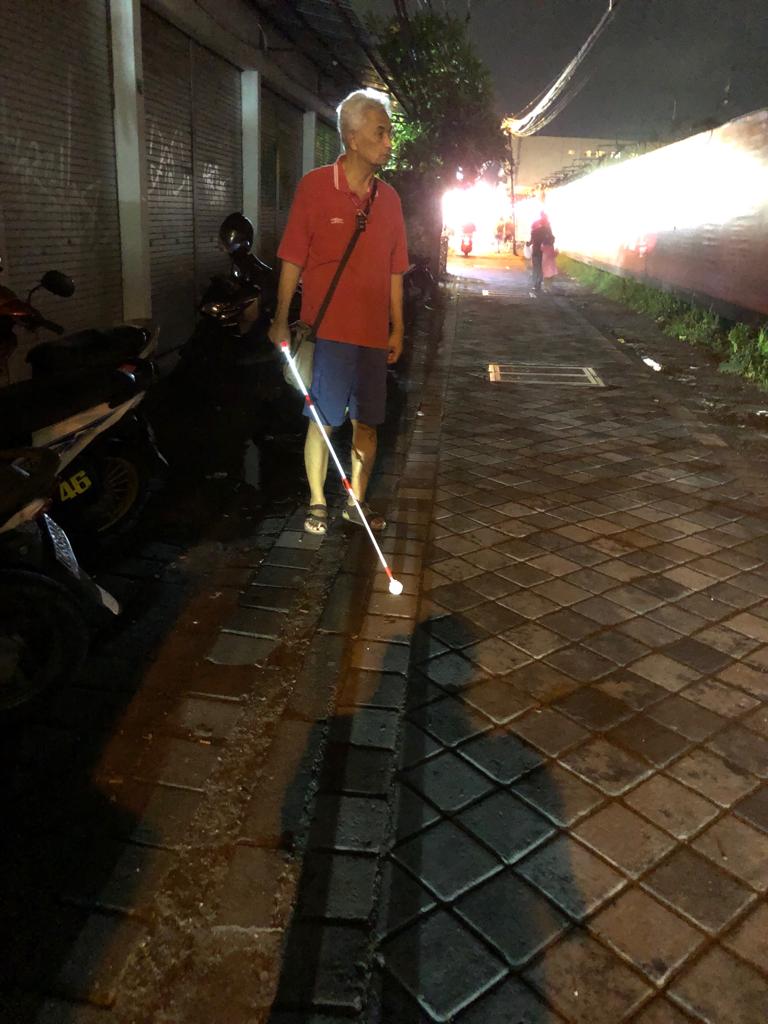
Gerard from Hoofddorp has the honor to test the first collapseable Blind Cane. He prefers to use a roller instead of a simple point, which is the first time that Marchena Caneis tested in this way. The reason Gerard is the first to test is because the cane would not fit his suitcase otherwise and we did not want this gentleman to go to Bali without his Marchena Cane.
The inhabitants of the city in Bali where Gerard stays do not know what the blind cane really means, so they do not recognise him immediately as a blind person, on the other hand he is much better visible, which reduces the risk of accidents. Perhaps time for a campaign to make it safer for the Blind on the move in this great city.

Louisette, our local designer / maker, has refined Peter Hanely’s design to create a connector system that is suitable for testing by users.
One walking stick is on its way to Bali, we had to speed up a bit, otherwise the walking stick would not fit in the luggage!
These connectors can be downloaded here, click on the image to download the 3D print file.
Male connector
Female connector
De 8 mm Gripper.
The result!
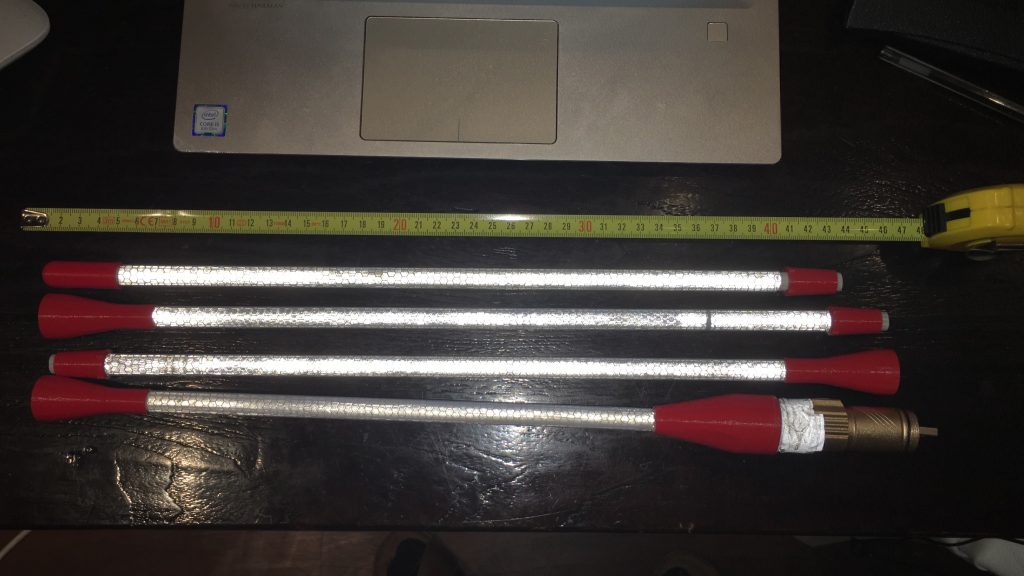
And as icing on the cake a nice ring to keep the flashlight focused and less whobbly.
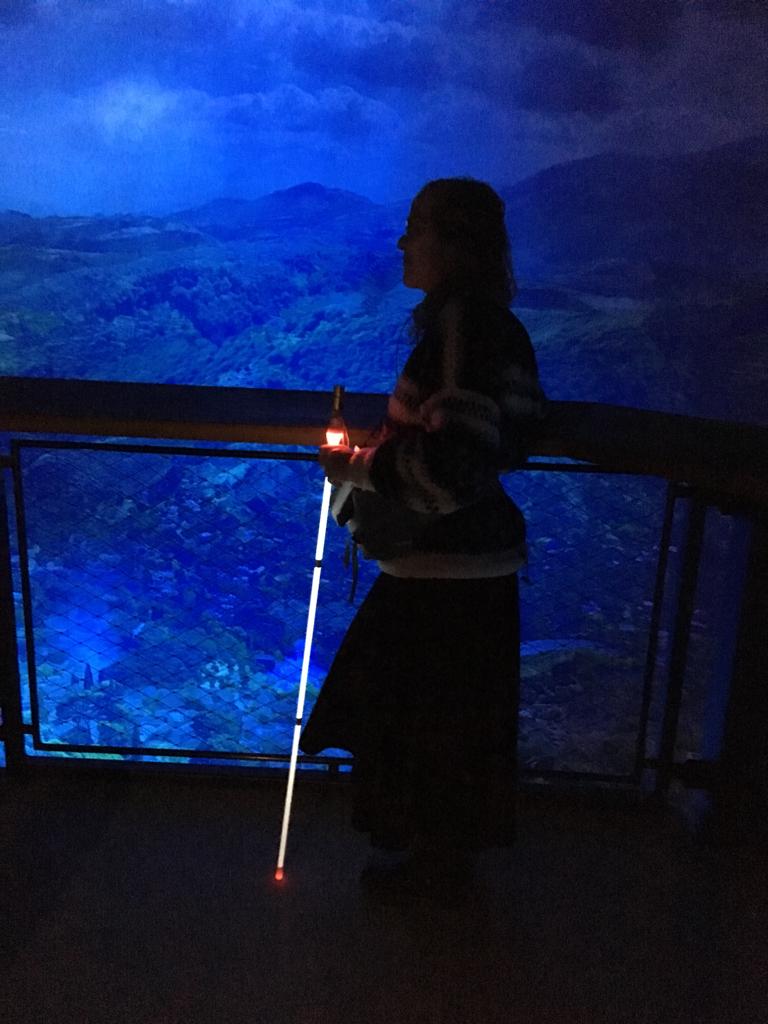
Debby visited a trade fair in Germany to network, get new ideas and find interested parties for her Marchena Cane. Once in Berlin she visited the interesting sites as well and made quite a show with her cane.
She’ll be back!
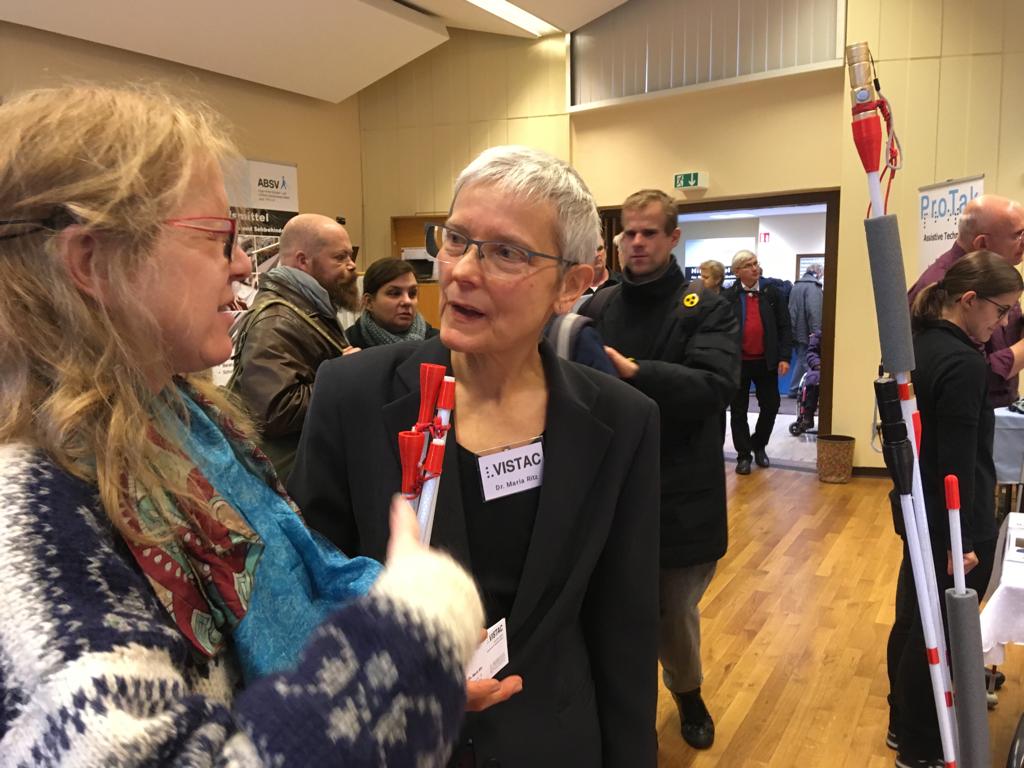
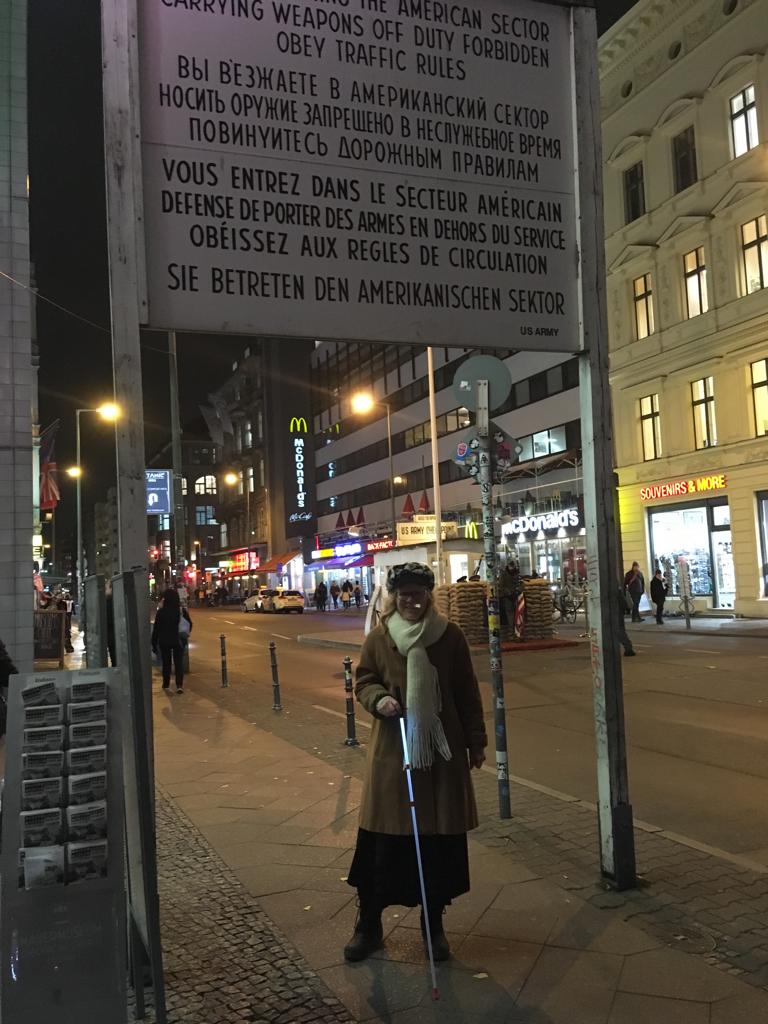


The post informs Dutch speaking VIP’s about an independent news site specifically aimed at VIP’s.

The Team presented their prototypes during a very well attended “Make Health” presentation. A total of 13 project teams proudly demonstrated their accomplishments.
The reason why private persons create solutions that people around them need differ, but they generally fall into three categories. The Solutions that exist are too expensive, they suck or simply do not exist yet. The team at “De Waag” help the team develop their Solution from Conceptual to Practical Prototype.
As did Debby’s Team. Her team had a bit of a head start on the other teams, because Debby had a clear vision of what the product would have to do. Her challenge was to get the right materials, only include the bare necessities and create a product that can stand the daily abuse of commuter travel and being slammed into objects all the time.
First the team prepared the presentation table and laid out the different prototypes the team created. Once this task was completed, we all joined the kick-off presentation in the Media room.
Paulien did a great presentation about the why and future the of Make Health platform careables.org. She also conducted a very interesting interview with the panel.
Then the audience went by each project demonstration. The pictures speak for themselves.
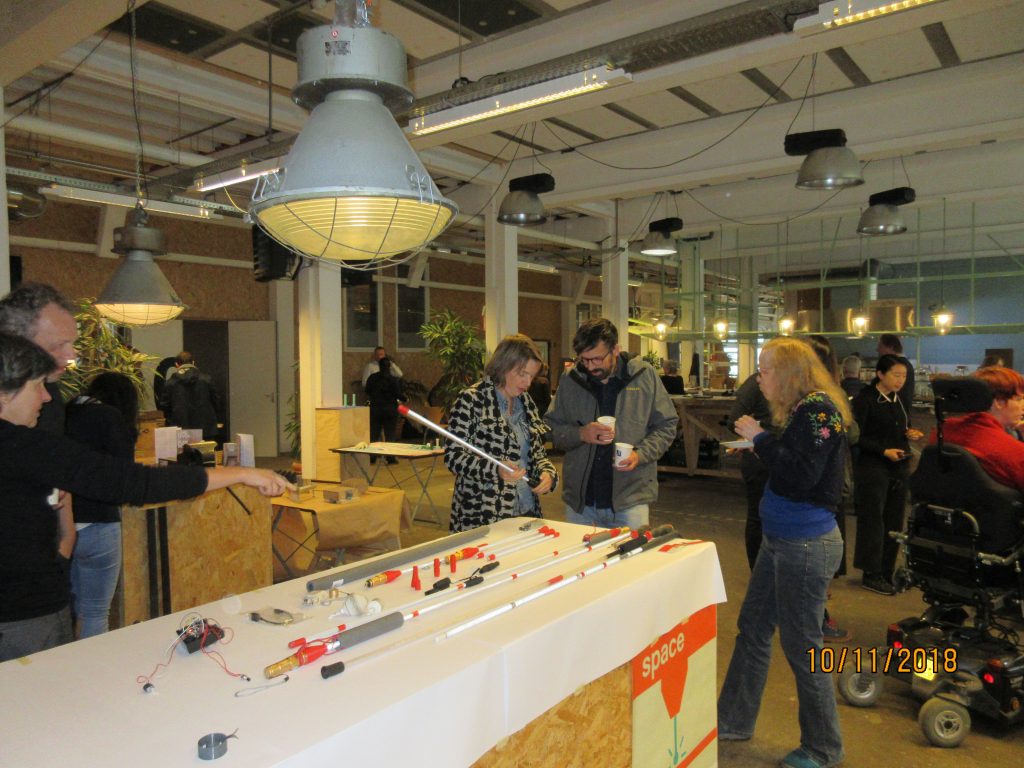
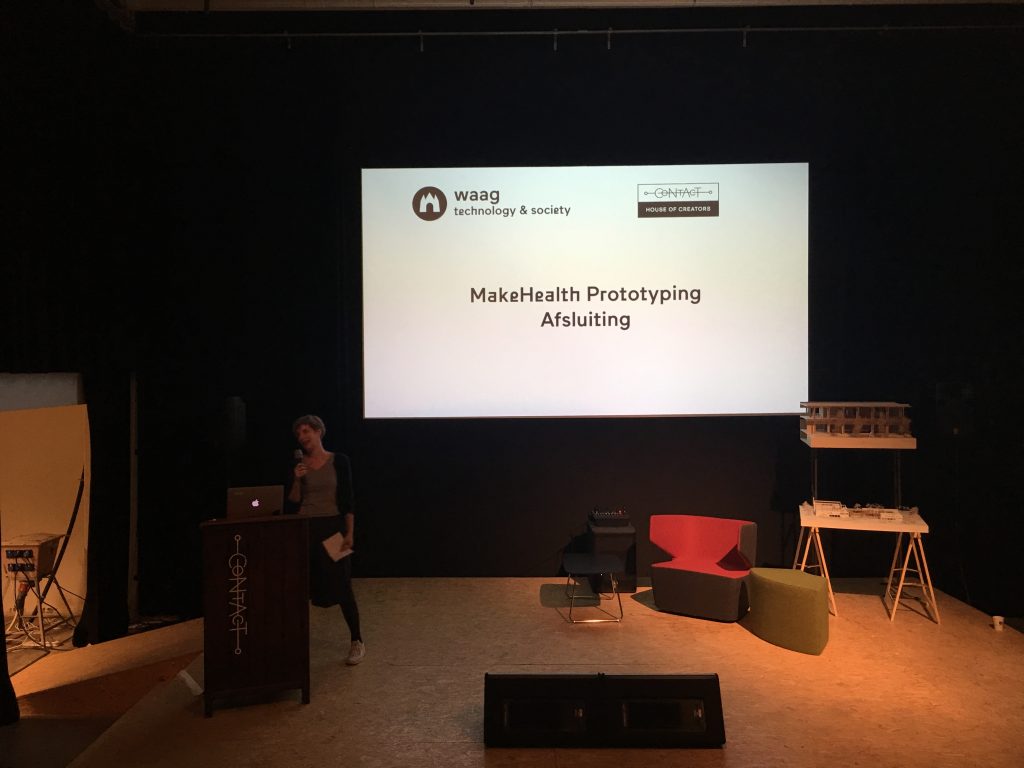
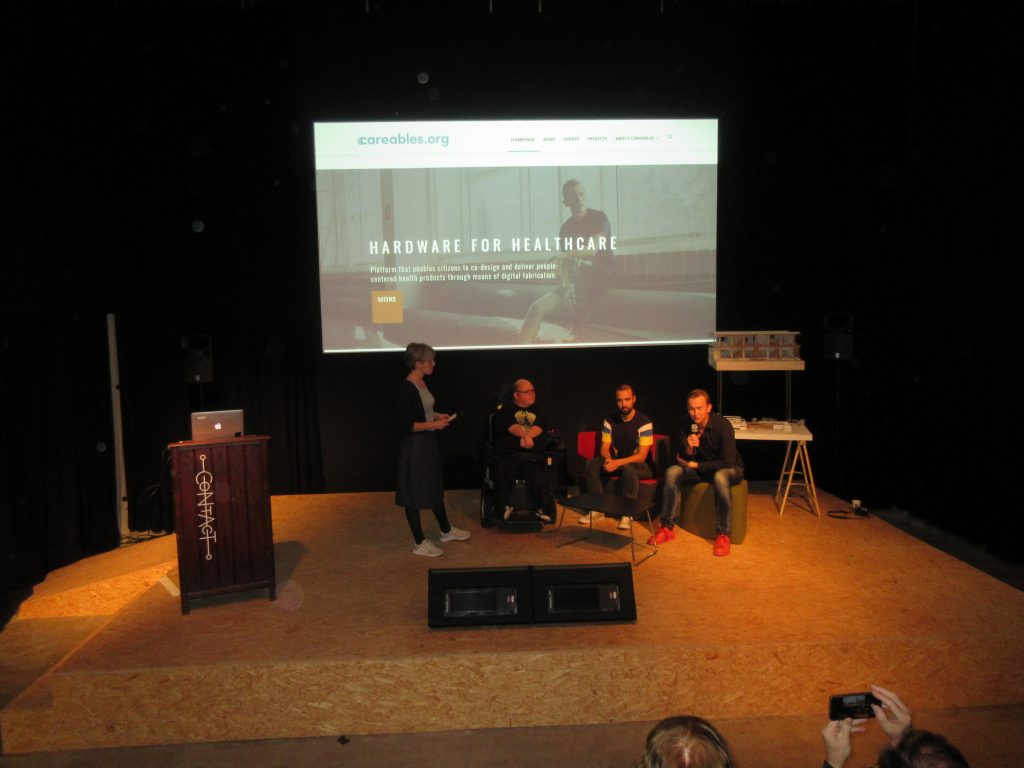
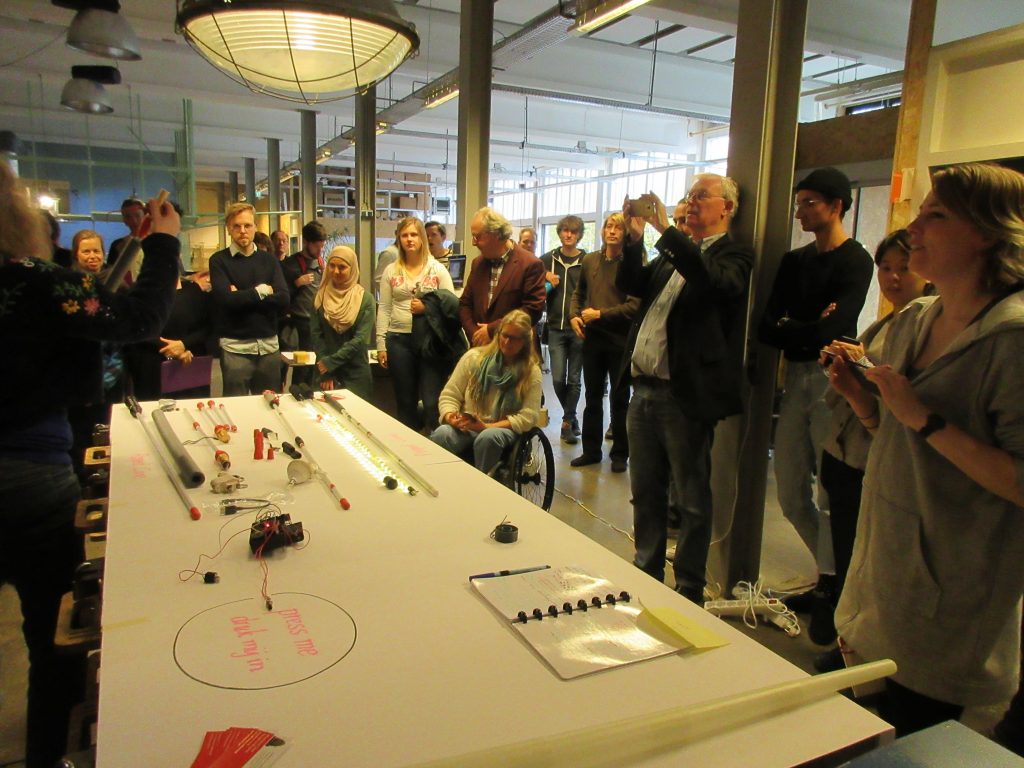
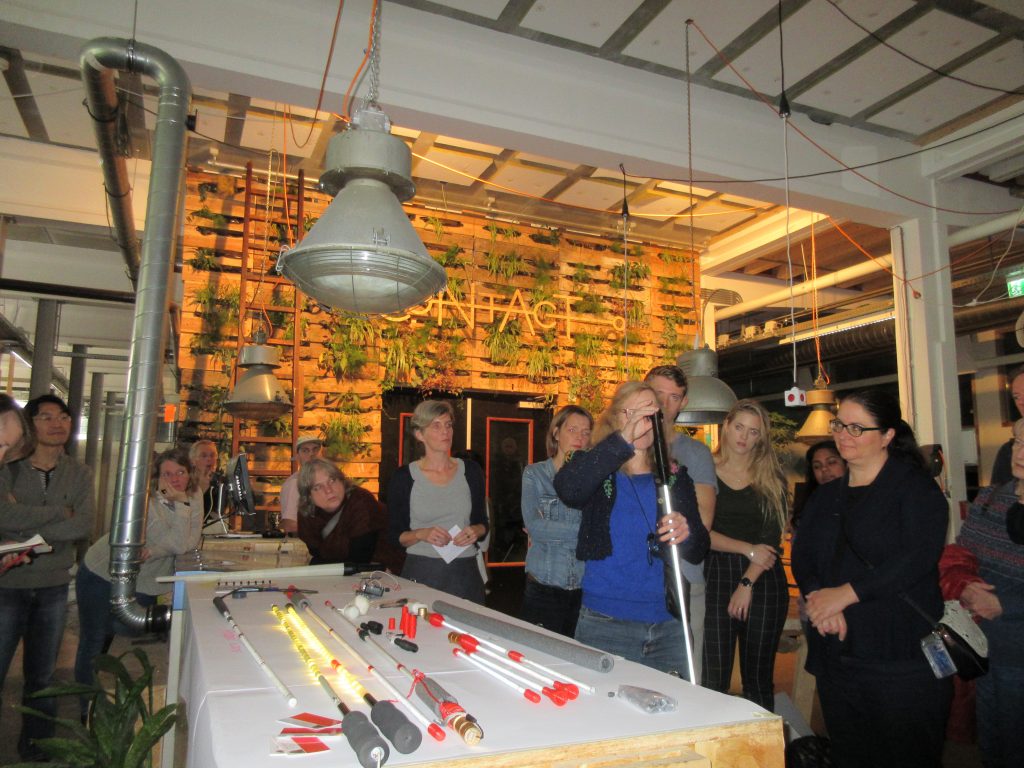
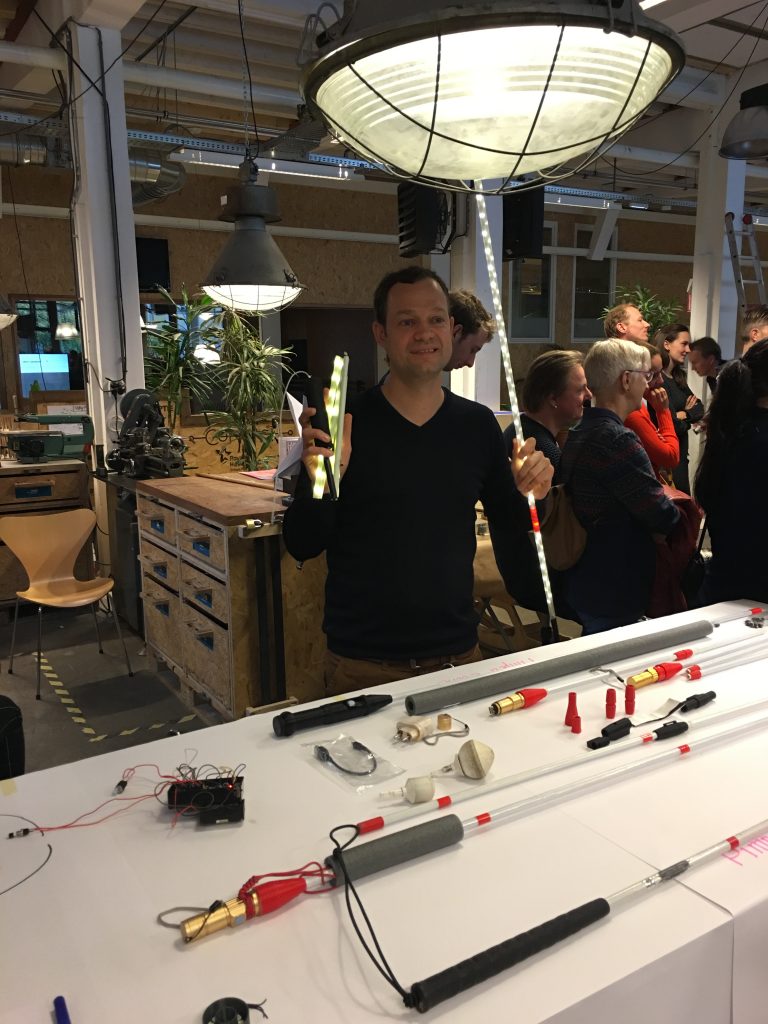
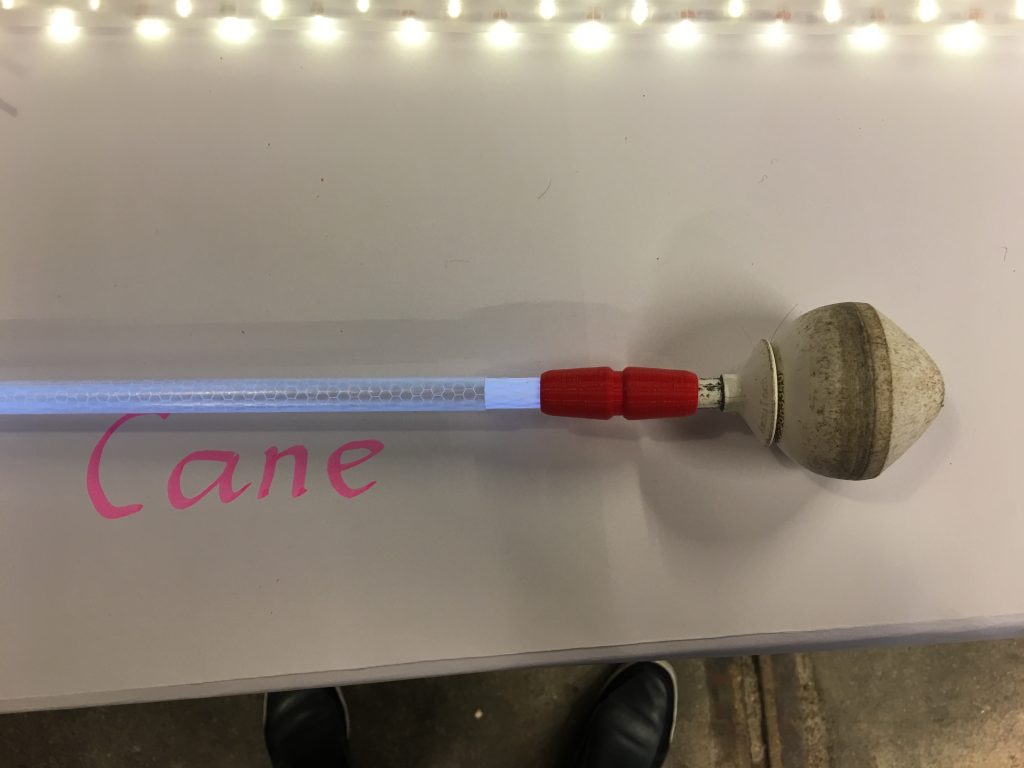
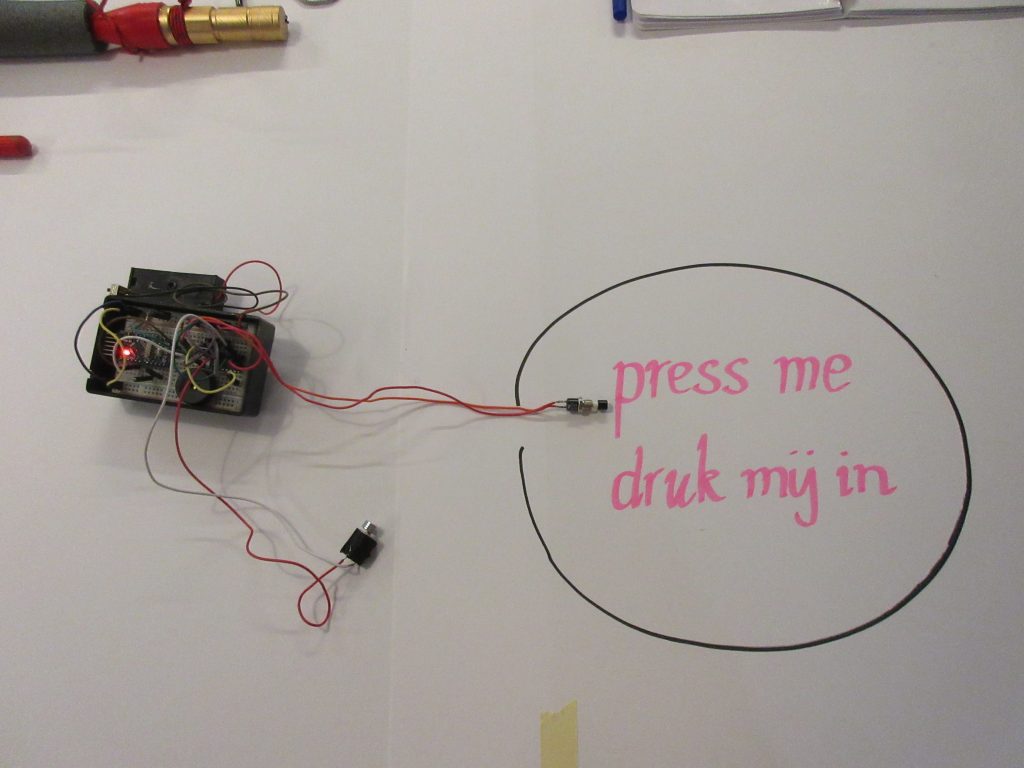
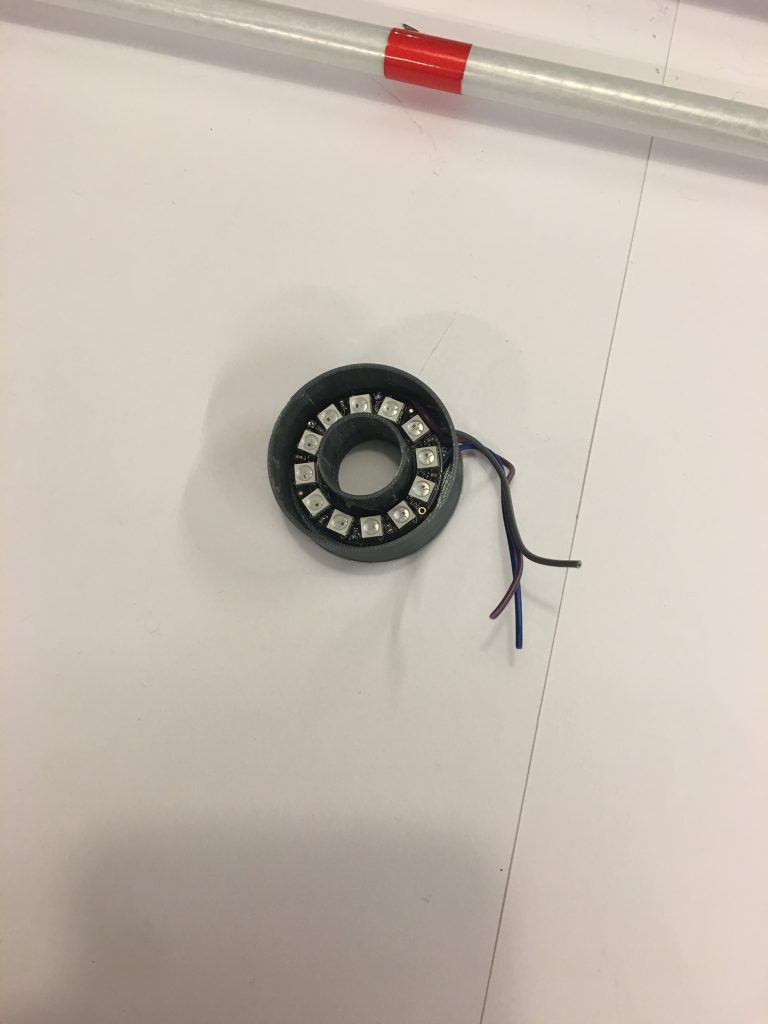
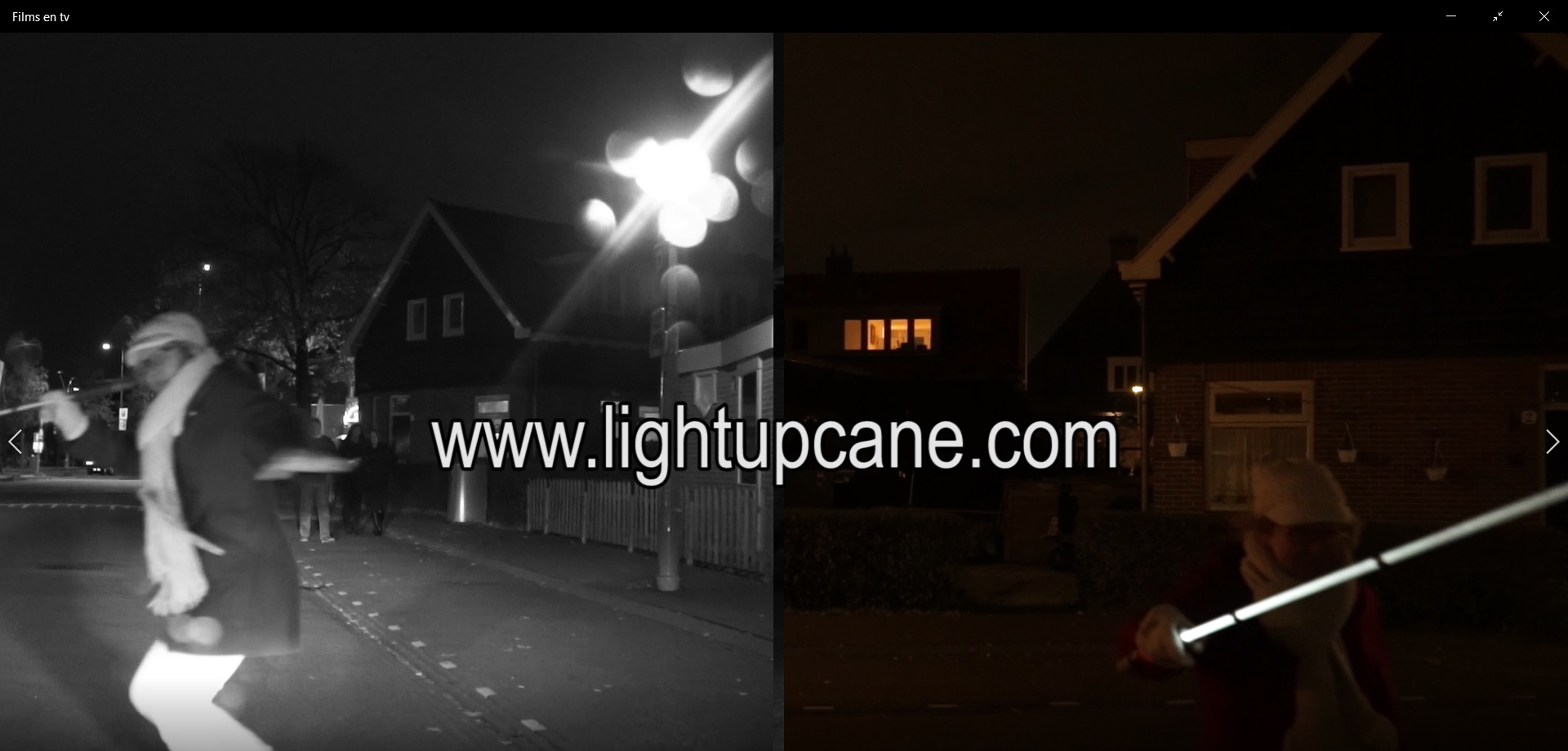
Light-up Cane vs Normal Blindcane. Any questions?
Debby is always in motion. She is tinkering with the idea to find balance of the cane that would make moving it from side to side easier. She took some pipe insulation foam as a handle, a couple of padlocks to place weight at the back of the flashlight, some duck tape and she is off!
Right now she is just checking if not having to lift the nose heavy cane is actually offset by the back-end weight. Instinctively one would assume that he added weight would add stress to the wrist.
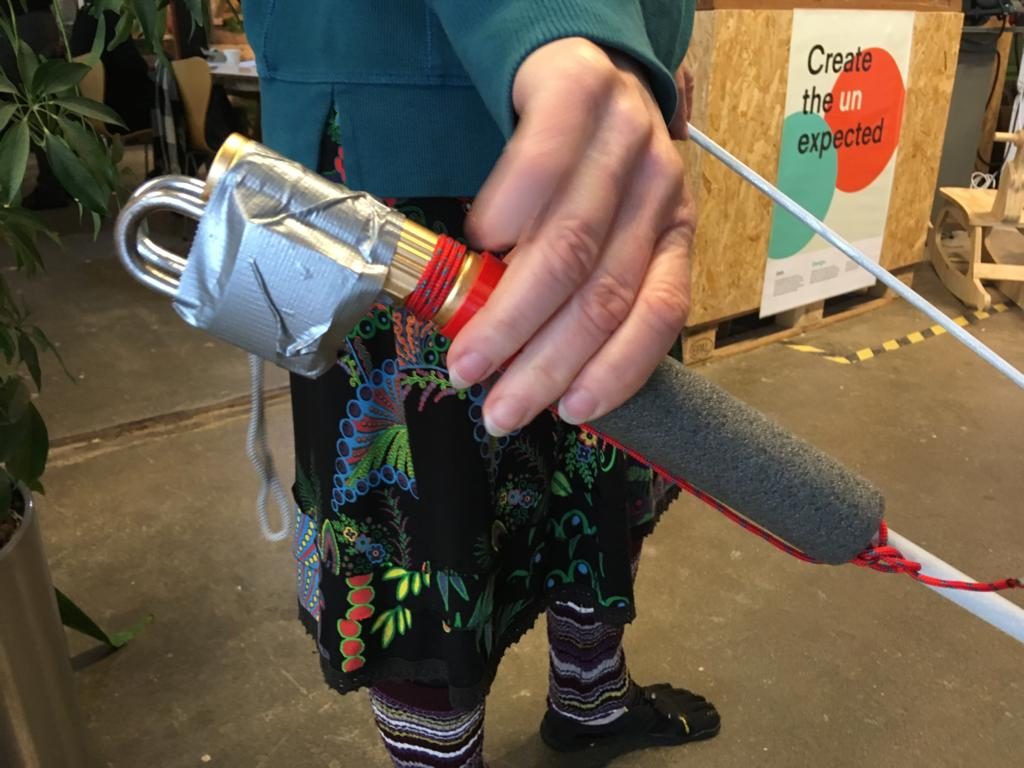
Well, Debby like to test assumptions and she feels that if you do not try, you really do not know. The picture below shows that the center of gravity of the regular blind stick is far ahead of the handle. That gives enormous pressure on the wrist to lift the stick.
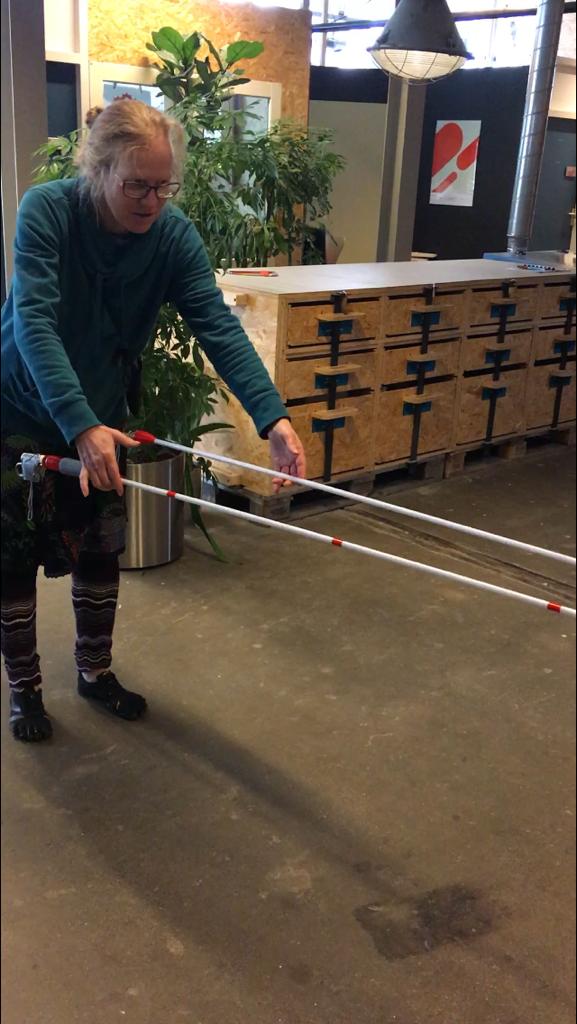
The center of gravity of the back-end loaded blind cane is much closer to the handle as the regular one. What the effect in terms of comfort and ergonomics will be will result from further tests.
We are getting another step closer to the production ready version of the Marchena Cane. We printed Peter’s couplings and after some finishing we test fitted the couplings. The couplings fit well and after some strenght tests we managed to break one, so we will have to beef up the design a bit and tweak for even better fit and minimal play of the fibre glass rods.
For a first version from idea-in-Peters-head-to-design-to-print-file-to-print-across-the-globe-to-actual-fit it is quite an accomplishment.
This is what it looks like now.
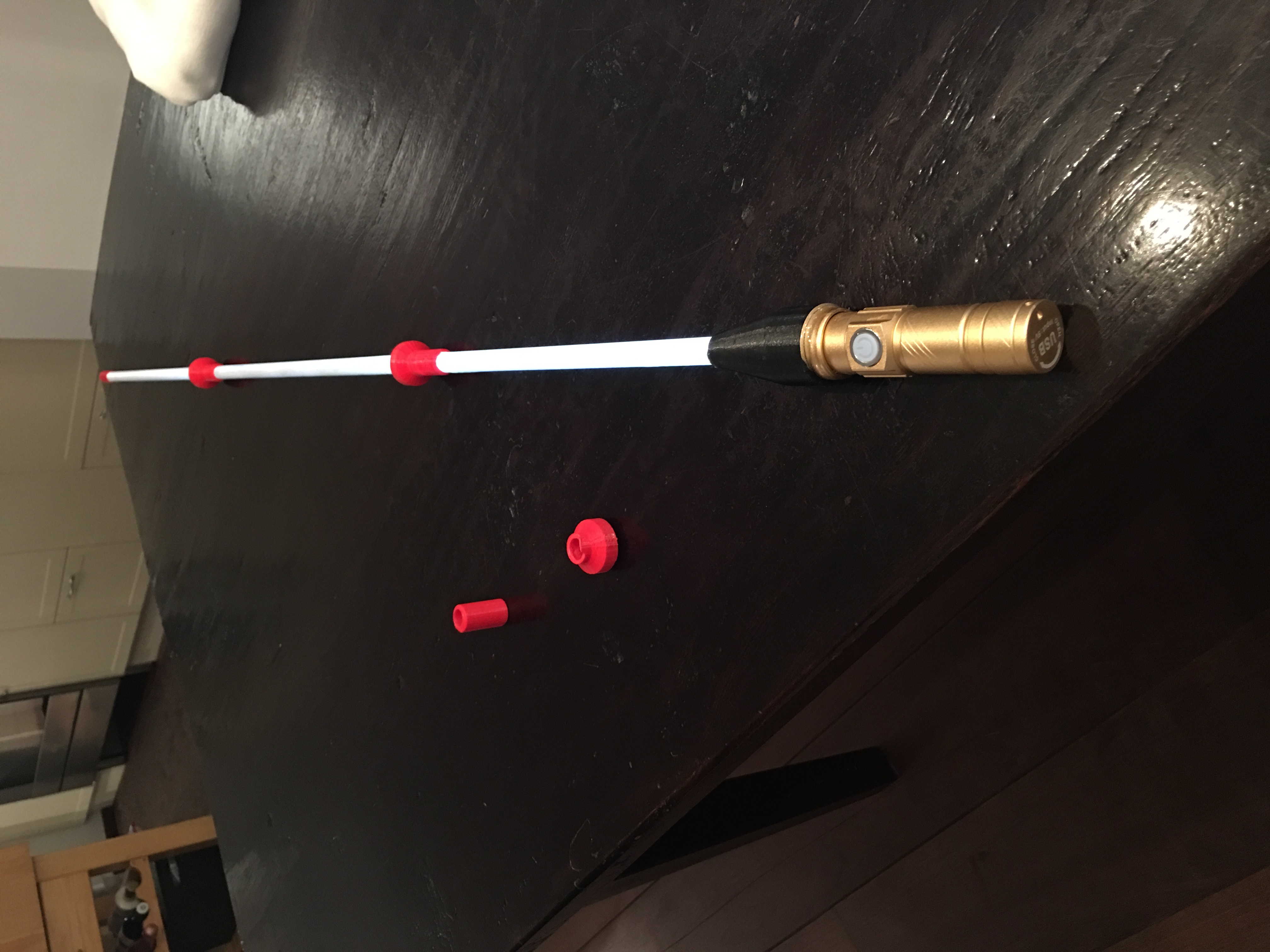
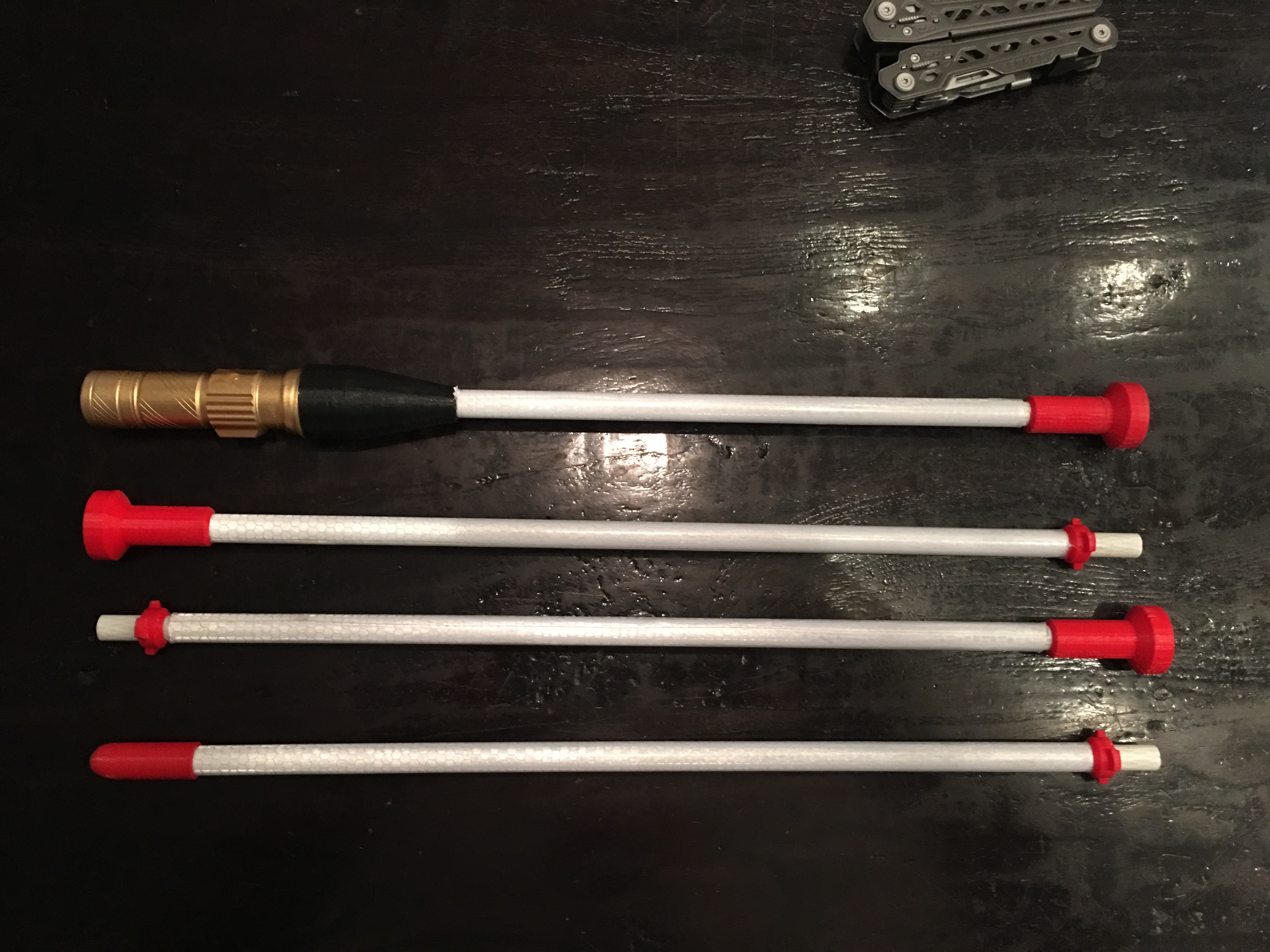
Some more designs in Peter’s Shapeways space.
Debby is admiring the pretty artwork made of “Bondaged rubber bycicle tires” at the Dutch Design Week exposition in Eindhoven, the Netherlands.
The Marchena “Light up Cane” fits só well in this venue. Street art meets art.
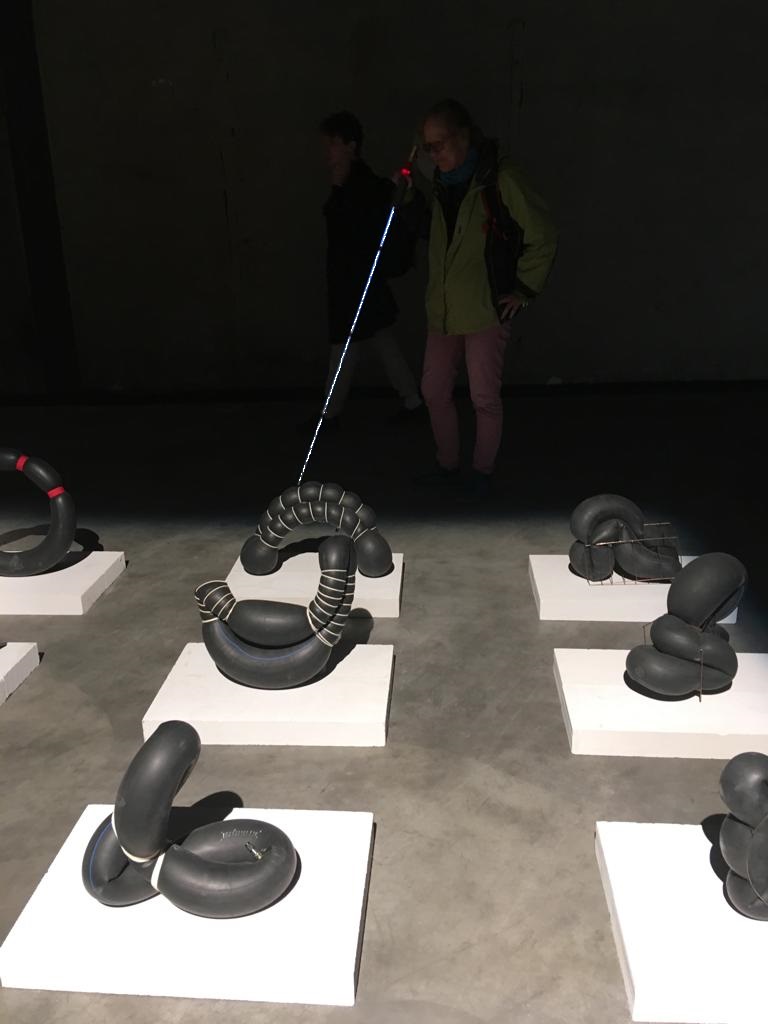
Peter Hanely, our designer from across the pond outdid himself again with a very lean design for the connectors to make the Marchena Light-up Cane collapsable.
The previous design was a bit difficult to print with conventional 3D printers, it works very well for Selective Laser Sintering (SLS), but this Technology is not available in all corners of the Globe (get it?). We will use that design for special editions of the Marchena Cane.
This is very elegant and lean. I mean, does is get any prettier than thís?
This design is being printed now and after succesful test, will be available on our BYO page.
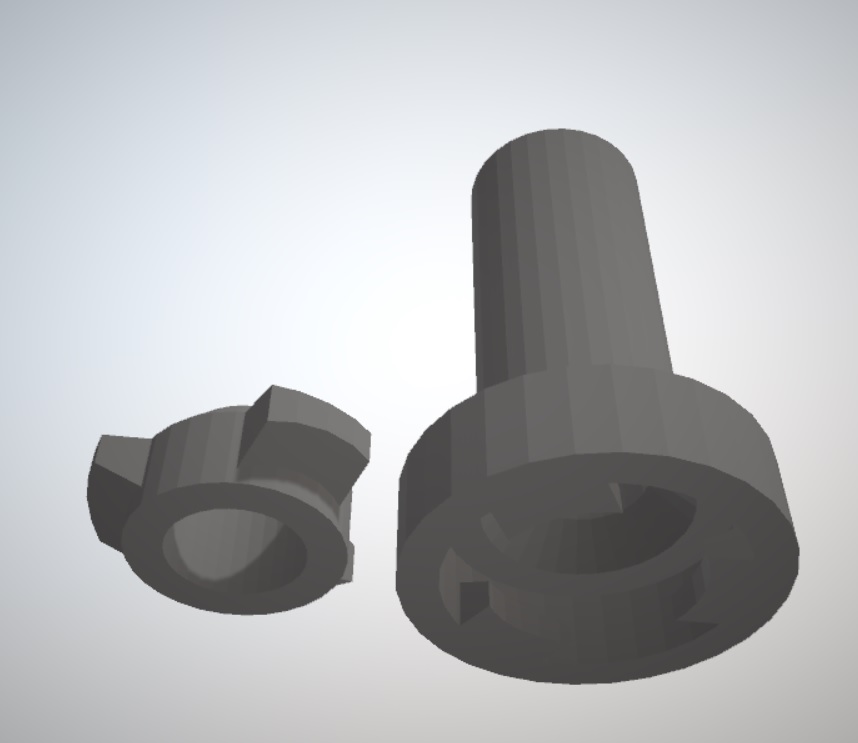

Our Light up cane tester in the US has passed the 10,000 subscribers. Awesome feat!
In order to accomplish this, Sam really commits time and energy to his channel, day in day out, year in, year out.
So press that subscribe button of Sam’s Channel and enjoy his “Blind lifers” look at the world and celebrate Sam’s success with us!
Especially for our Local Dutch Supporters!
You can help Debby fund getting the Light-up-cane to production via her getfunded.nl campaign.
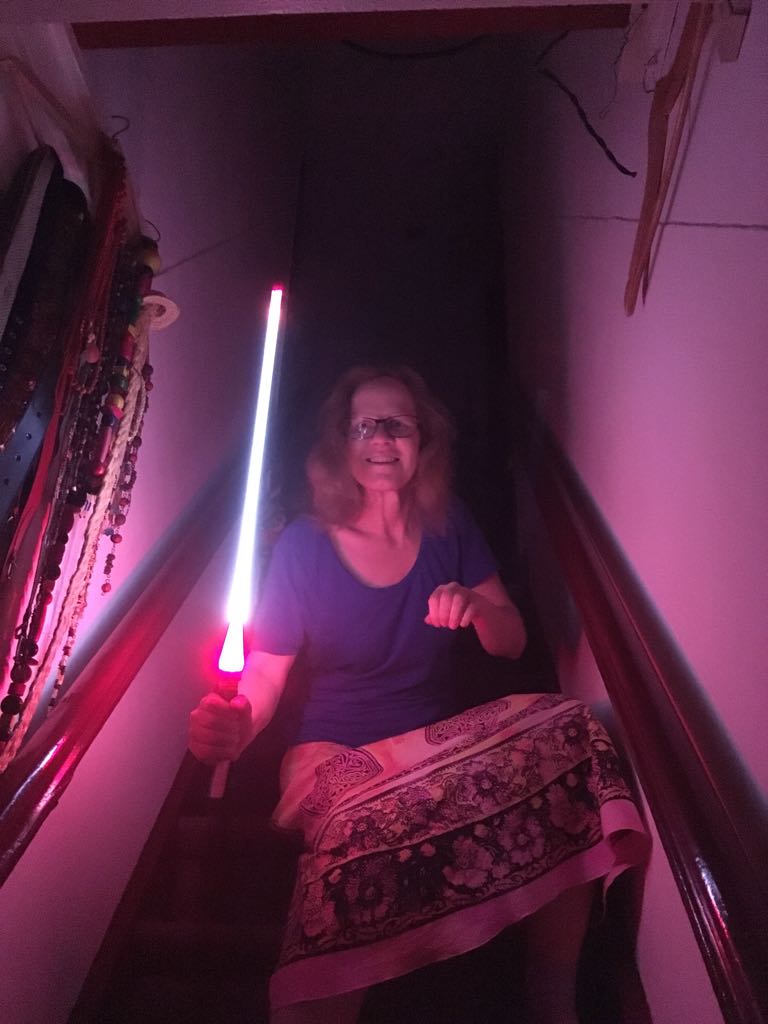
Debby started her GoFundme campaign. The aim is to get funds to make the cane ready for production and the first donations are coming in!
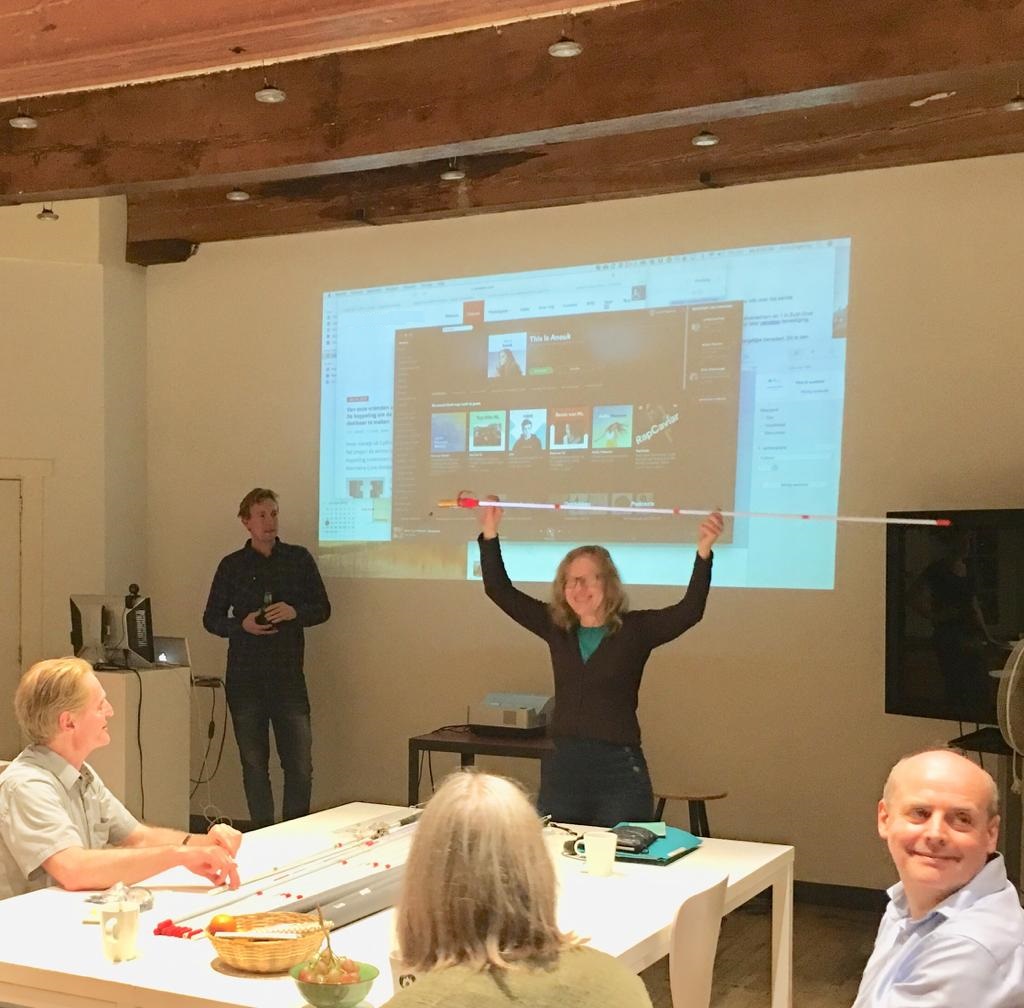
The Fab Lab De Waag opened the doors for Debby to perform the presentation of her New Blind Cane.
The pictures speak for themselves!


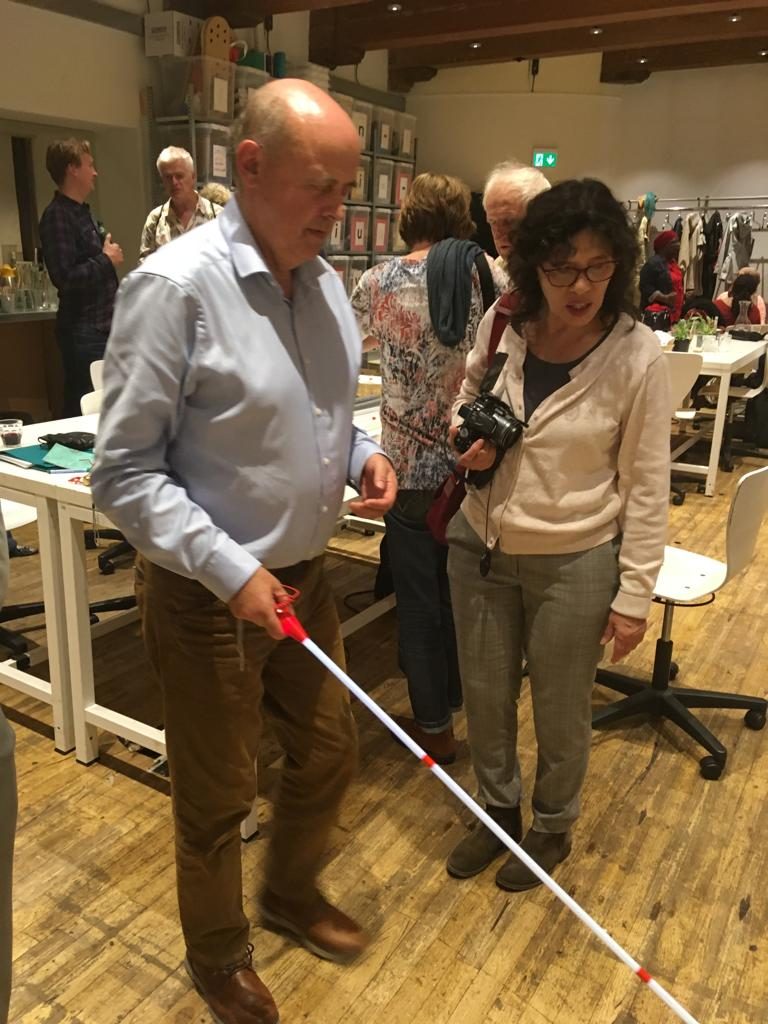
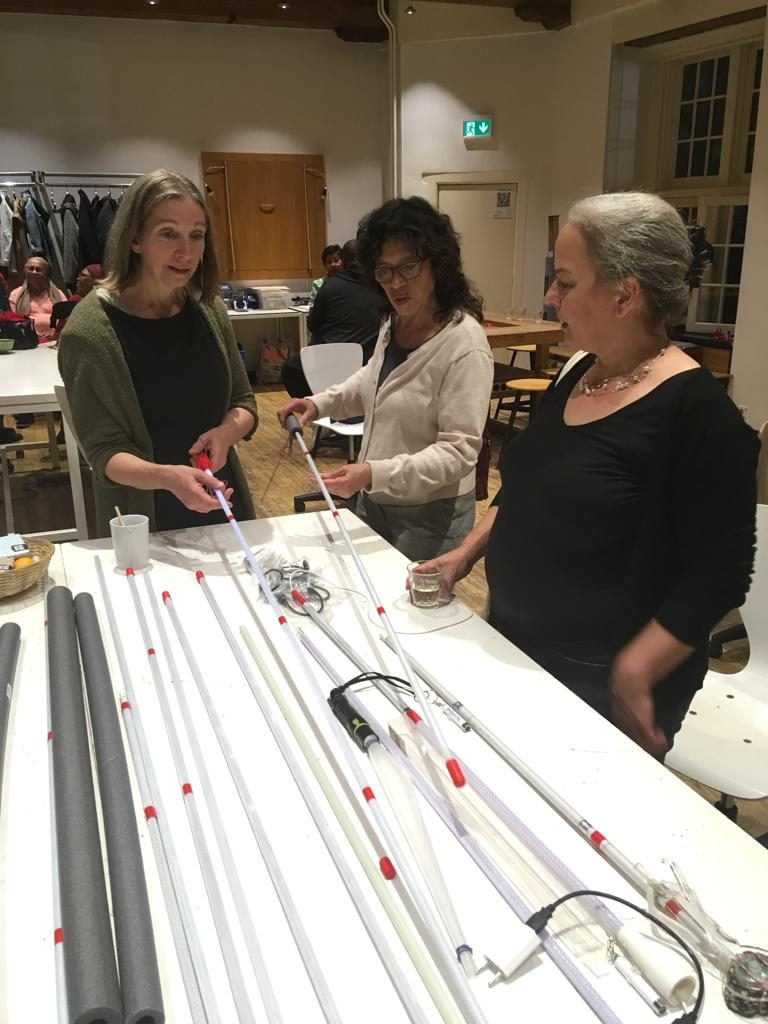
Peter Hanely from California designed the first version of the coupling for the project to make the Marchena Cane divisible.
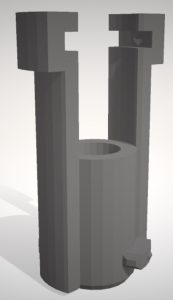 This link fits onto itself, so the design is very easy to replicate for production. The design is also made in such a way that the current cane can be easily adapted. The VIB does not have to buy a new cane!
This link fits onto itself, so the design is very easy to replicate for production. The design is also made in such a way that the current cane can be easily adapted. The VIB does not have to buy a new cane!
Naturally, the link will be tested by our discerning VIB test team (Oh dear!) and improved on the basis of their feedback.
The first step for enhancement of the Marchena Cane is there!
Peter has designed more beautiful things, you can admire his works of art on his shapeways site and download the 3D print files for your own project for a friend’s prize.
For the more technically inclined, here is the link to Peter’s github Project page.
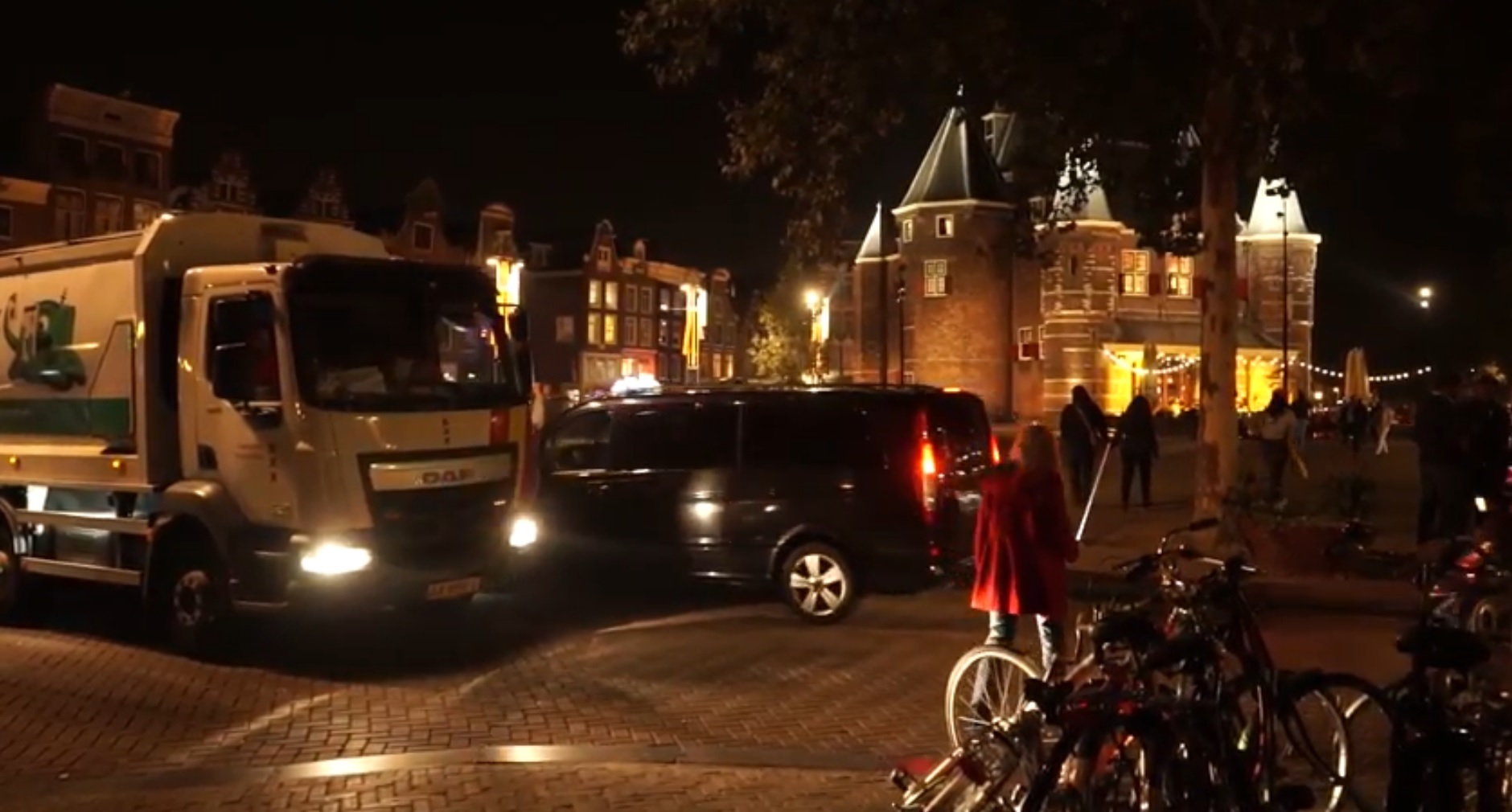
Debby tests the Marchena Cane in Amsterdam, close to the FabLab De Waag.
Just check out how car drivers, pedestrians and people on bikes take notice.

Debby is testing the Marchena Cane in Amsterdam, in the Historic Center, close to the FabLab “De Waag”
Today Debby met a blind gentleman close to the EYE in Amsterdam. He showed his measure to make the Blind cane more visible.
Debby invited him to the Marchena Cane Reveal event at the Waag on the 15th, October. We hope to welcome him and his wife at the event. The more the merrier!
The gentleman allowed Debby to take a picture of his idea to make his Blind cane more visible.
So you see, the idea is not new and it is very much alive!
Moral of the story: Broadcast what the Marchena Cane can offer. The more people learn about the new possibilities, the safer the traffic will be for VIB’s!
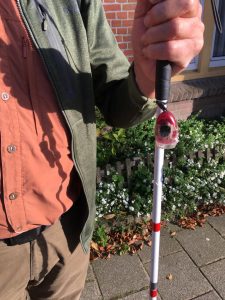
This VIB makes sure he is safer in traffic with his own rendition of the Marchena cane V0.1!
We downloaded the STL files from the blindjedi website and printed them on a very basic 3D printer. If this works here, it works everywhere in the world.
The result is functionally fine, and the print quality is fine for daily use. All parts fit well and minimal after-print cleanup is needed.
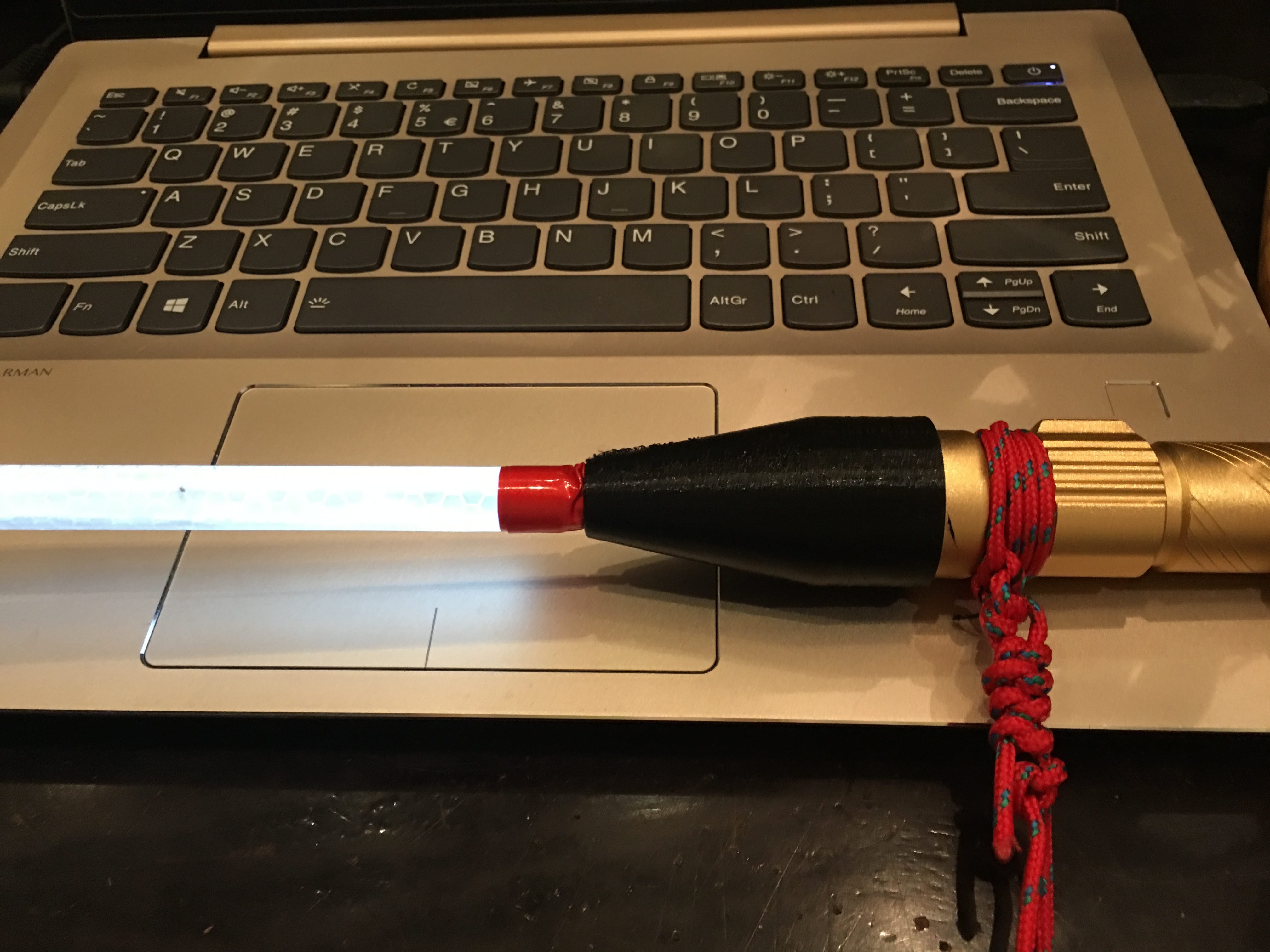
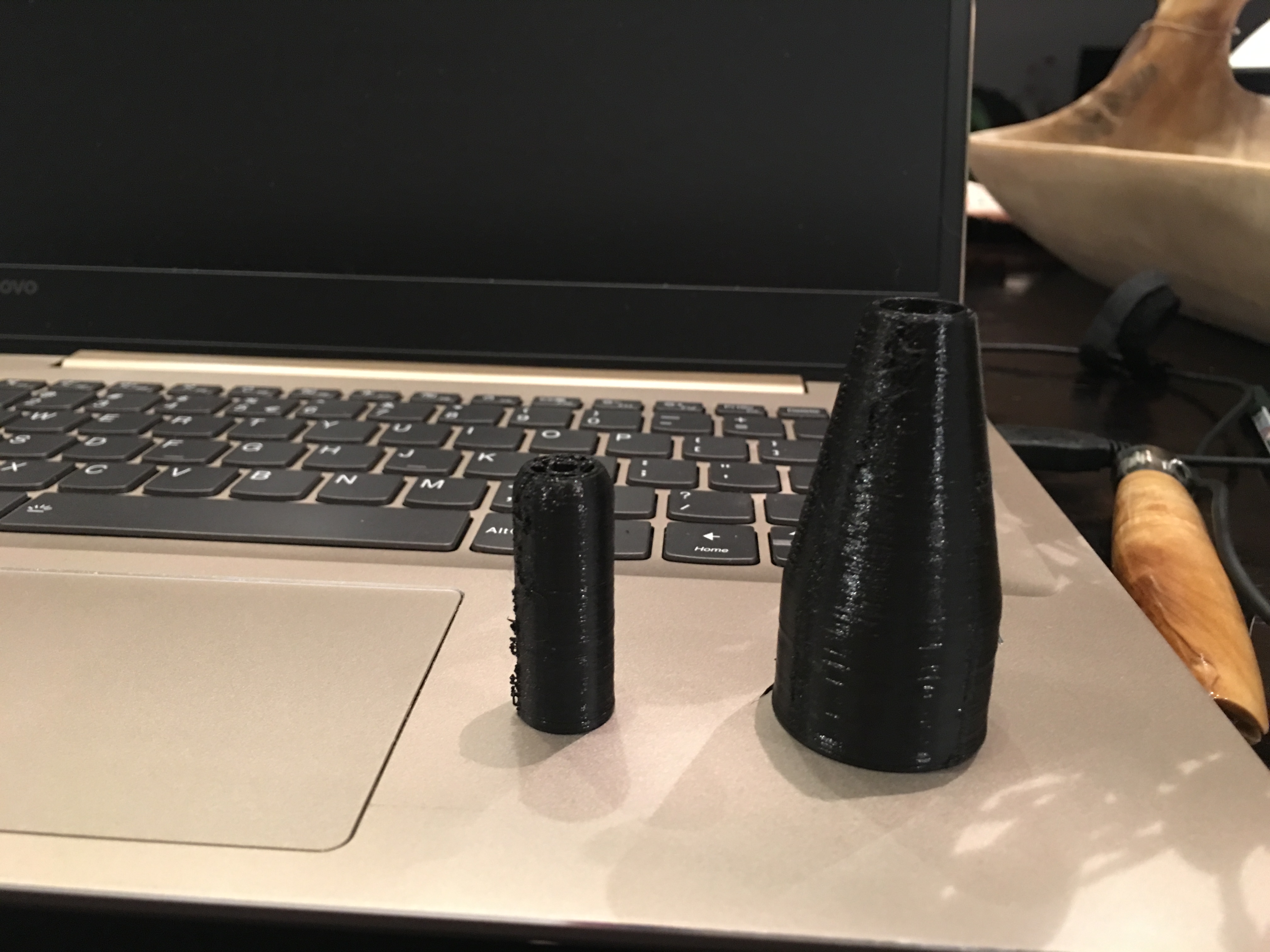
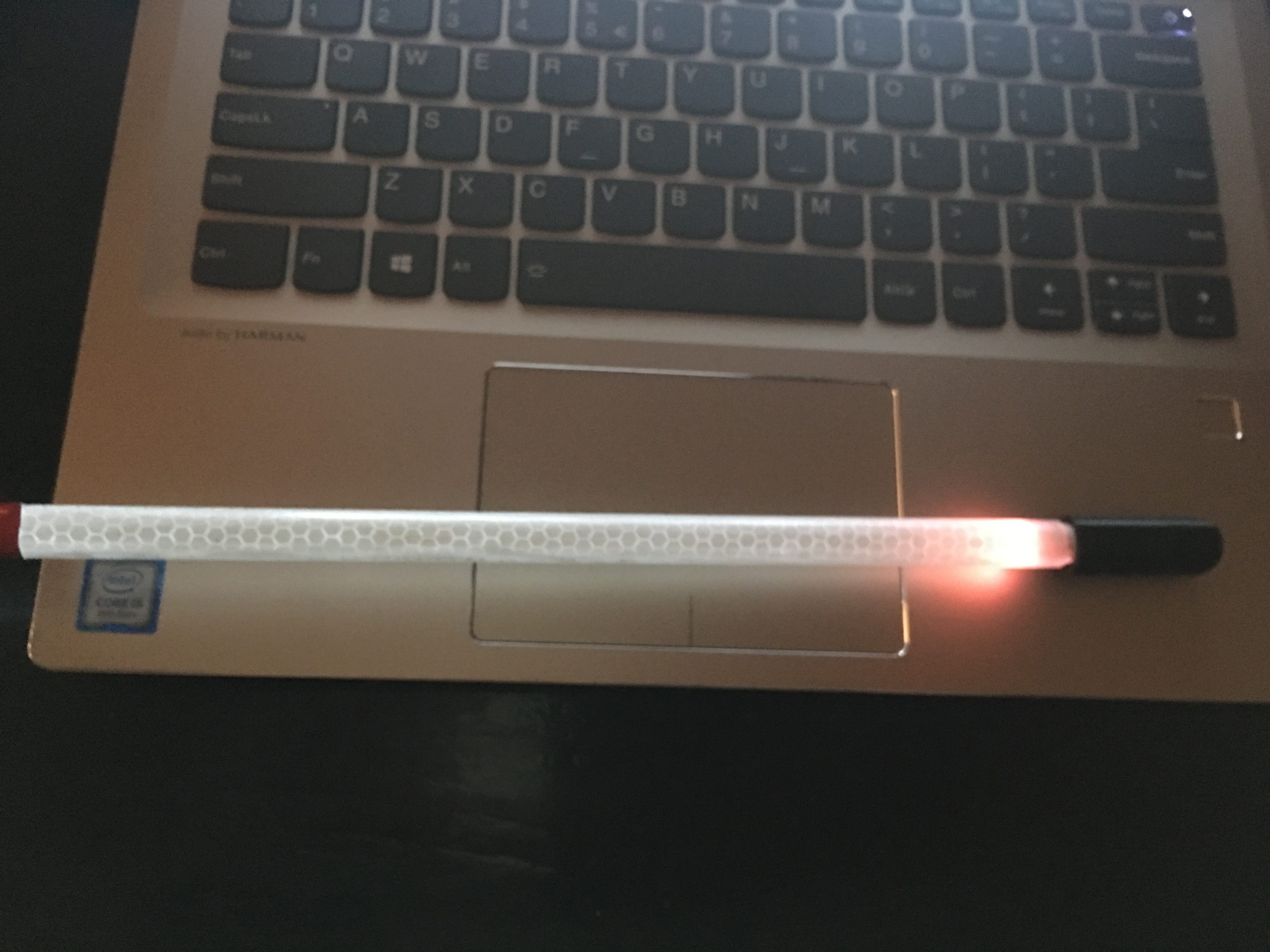
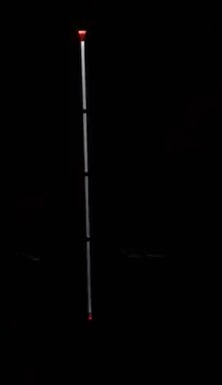
We tested the Marchena Cane in pitch black, the super reflective layer makes it visible really well. When you switch on the light, the cane is really noticable.
With the flicker mode on, you cannot miss it!
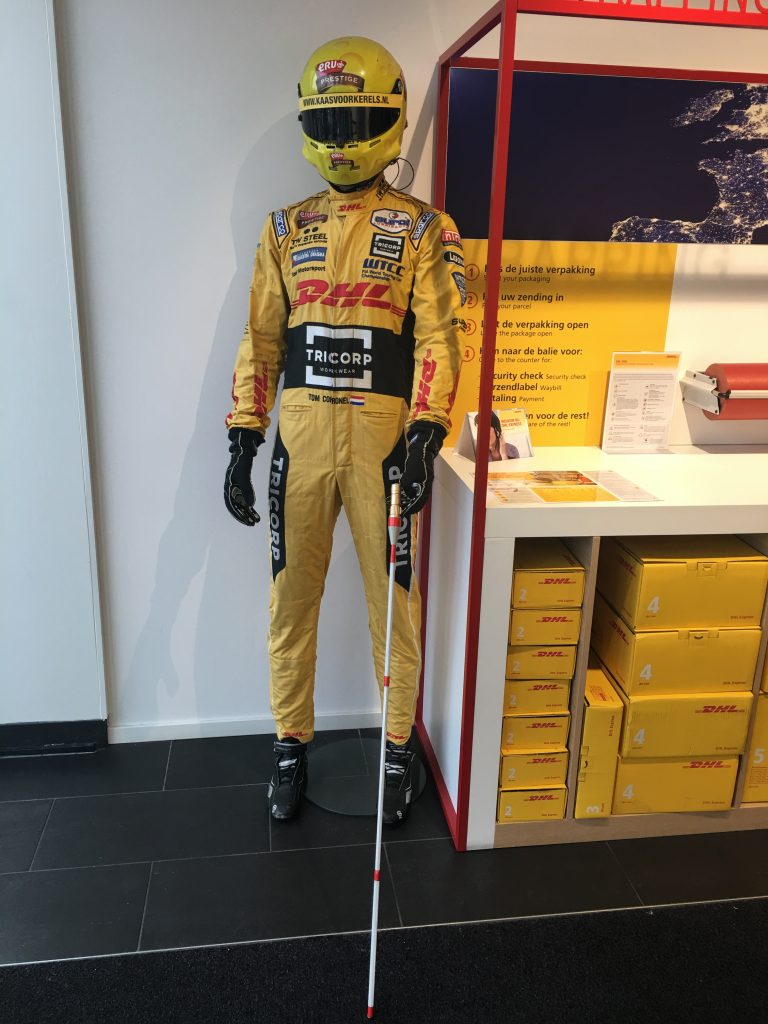 The first production Marchena Cane Prototype was sent off via DHL today. Our first customer is Sam of TheBlindLife vlog.
The first production Marchena Cane Prototype was sent off via DHL today. Our first customer is Sam of TheBlindLife vlog.
This version has a simple rechargeable flashlight with three modes; High, medium and Flicker mode.
In “High” mode the Cane is a beauty to behold and in flicker mode it can not be missed. We hope Sam will enjoy this modern day rendition of the nearly 100 year old Blind cane.
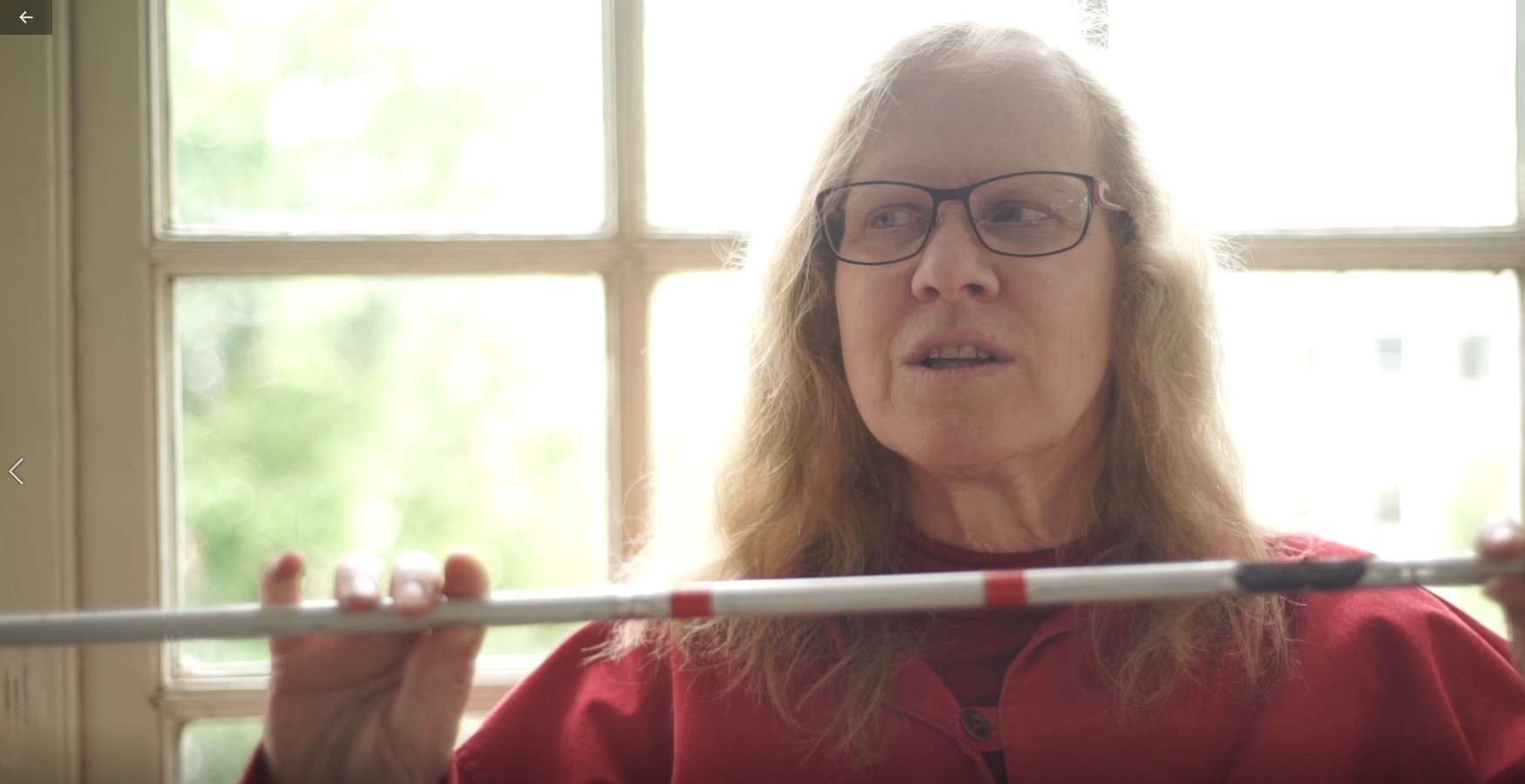
Correctbook deserves yout attention. What is Correctbook for me? It is my Ideabook and an opportunity for children in Africa and Latin America to learn to read and write.
How do you work with ideas? You write something on a piece of paper, or something you happen to have with you, you scratch something, throw papers away and then it is there!
Just that is a shame about the messy paper with all scratched ideas and especially a shame about wasting all that precious paper! This is where Correctbook, an endless rewritable notebook comes in. Think of a mini-whiteboard that you can always use, never worry about empty batteries and never look for papers again. And what comes with it makes it completely! Correctbook donates 25% of the Business to Consumer and 10% Business to Business to Correctbooks for children in Africa and Latin America.
I do not want to be without it, it worked for me!
Visit Correctbook and reward yourself with endles writing!
Debby executed a road test in busy Amsterdam close to the Central Station, where she had the accident that set off the project.
As she raised her lighted can, people responded instantly.
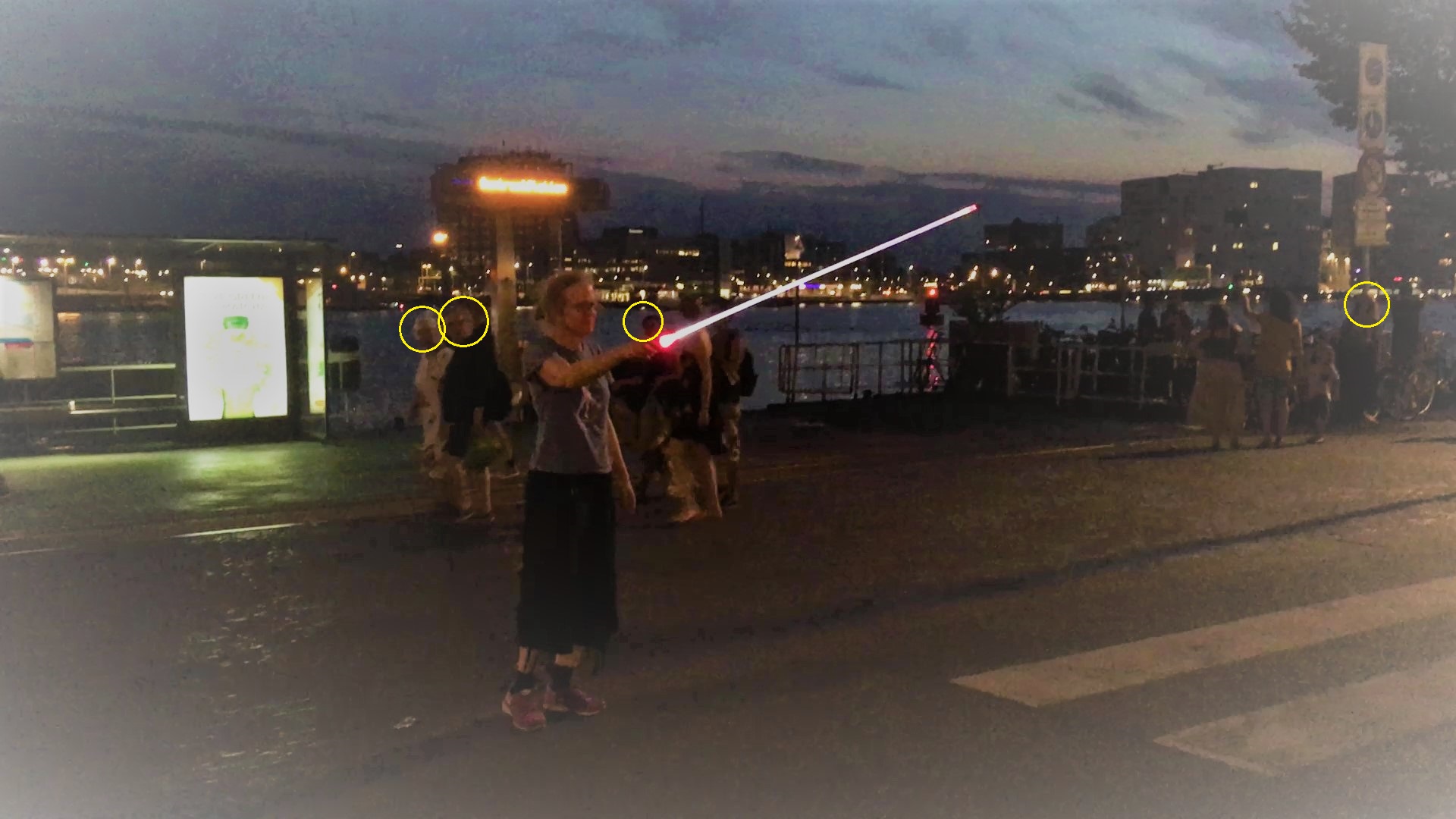
How cool is that?
On 15 october 2018 Debby had her reveal of the “Marchena Cane”. It was a success, now she is forging ahead to fulfill her dream.
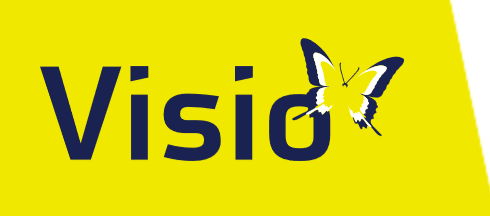 (Dutch Site) At Visio everyone can go to questions about being visually impaired or blind. Visio offers information and advice, but also various forms of research, guidance, rehabilitation, education and living. These services are for people who are visually impaired or blind, even if they also have an intellectual, physical or other sensory impairment. Personal and professional stakeholders can also contact Visio for information and expertise promotion.
(Dutch Site) At Visio everyone can go to questions about being visually impaired or blind. Visio offers information and advice, but also various forms of research, guidance, rehabilitation, education and living. These services are for people who are visually impaired or blind, even if they also have an intellectual, physical or other sensory impairment. Personal and professional stakeholders can also contact Visio for information and expertise promotion.
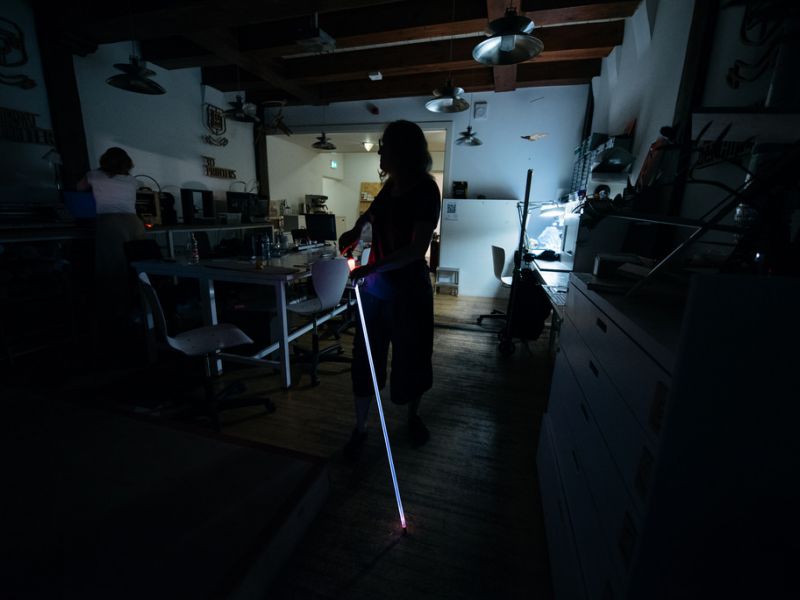
During the first MakeHealth: Prototyping series participant Debby Marchena developed a light-giving white stick in FabLab Amsterdam. During this MakeHealth Meetup on the International Day of the White Stick Debby presents her prototype and ambitions. For visitors there is the possibility to purchase one of the first prototypes of the ‘Merchana Bright White Cane 1.0’ as an early adopter. For further development Debby is looking for feedback from users and their environment. Through the open source sharing of her knowledge and experience, Debby ultimately wants to spread light around the world and increase the safety of people with visual impairments.
Register here for free for this event.
Pimp my cane
Debby Marchena lives in Amsterdam and has a visual impairment. She was hit earlier this year by a motorist who had not seen her in the dark. To increase the visibility of people with a visual impairment for their environment, her white stick is provided with light. The lighted white stick, Jedi style, should help prevent accidents of this kind.
Debby is further developing and improving her prototype. On 15 October, Debby will launch a public campaign to share its model open source. Her ambition is to prevent accidents of this kind, to allow people with visual impairments to use this model and that in 2030 the algorithms in self-driving cars will recognize her stick and respond to it. The program consists of a presentation of the development trajectory and realization of the luminous white stick and a brainstorm about preconditions and further development.
About Made4You
In Made4You, citizens, healthcare professionals and makers work together to design and develop personalized care applications. Care has changed radically in the past century. A growing group of citizens experiences that products and services in healthcare are too expensive, do not match their needs, or simply do not exist (yet). With the advent of technology, the possibilities for developing digital healthcare applications have been increased. With MakeHealth we want to develop new, open design applications and publish them online.

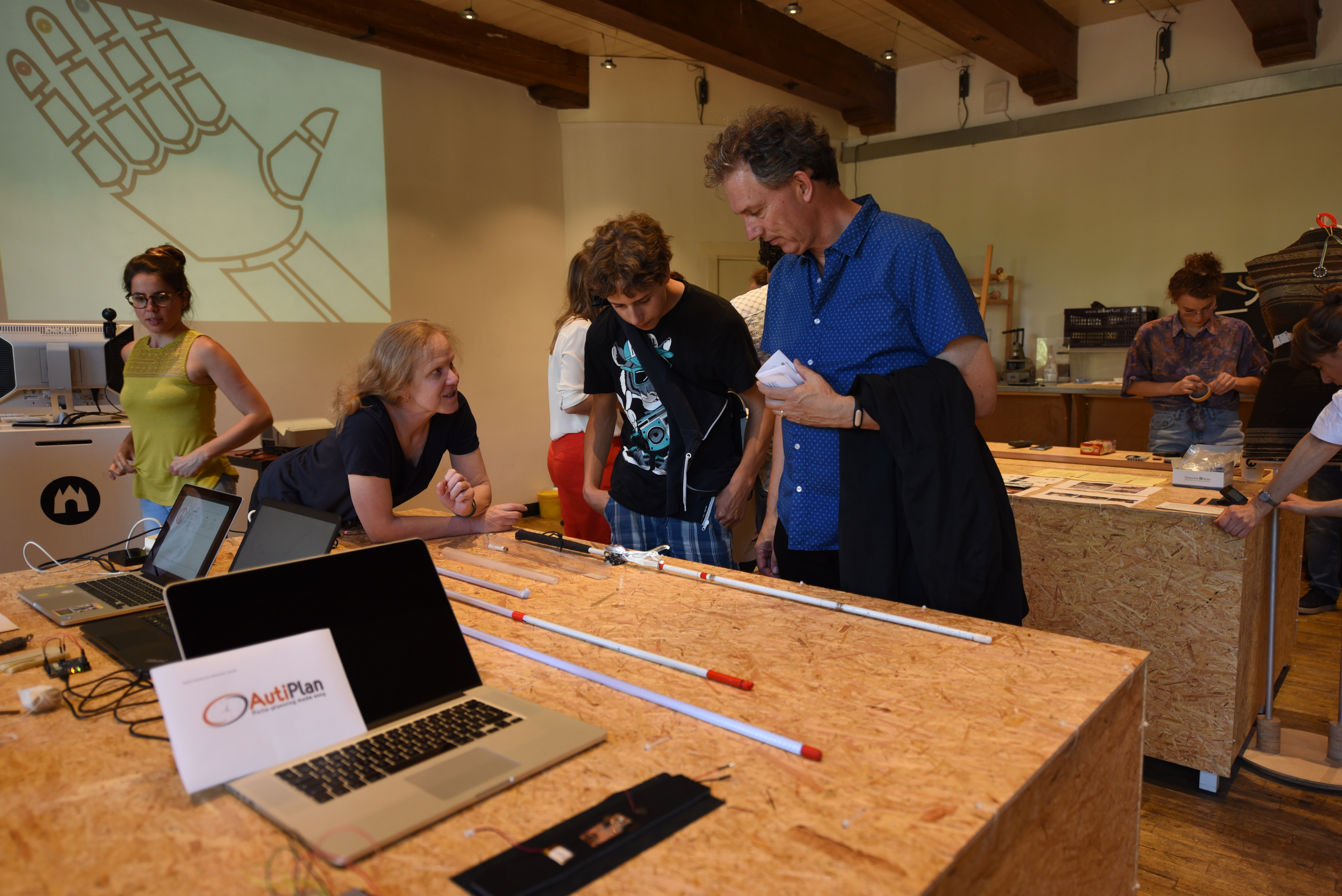
During the final presentation of Prototyping Health in the Waag, everyone could admire the prototypes. The question, which almost everyone asked, was: Does not this still exist? Is not it logical to equip a white stick with light?
There are light swords, as toys and for role play.
There is a white stick of Laser, as light, without tactile feedback, very inconvenient for the blind, especially if the battery fails. Furthermore, as far as is known, there is nothing.
On 15 October next is a presentation in the Waag of my Pimped Cane, in the context of Prototyping Health.
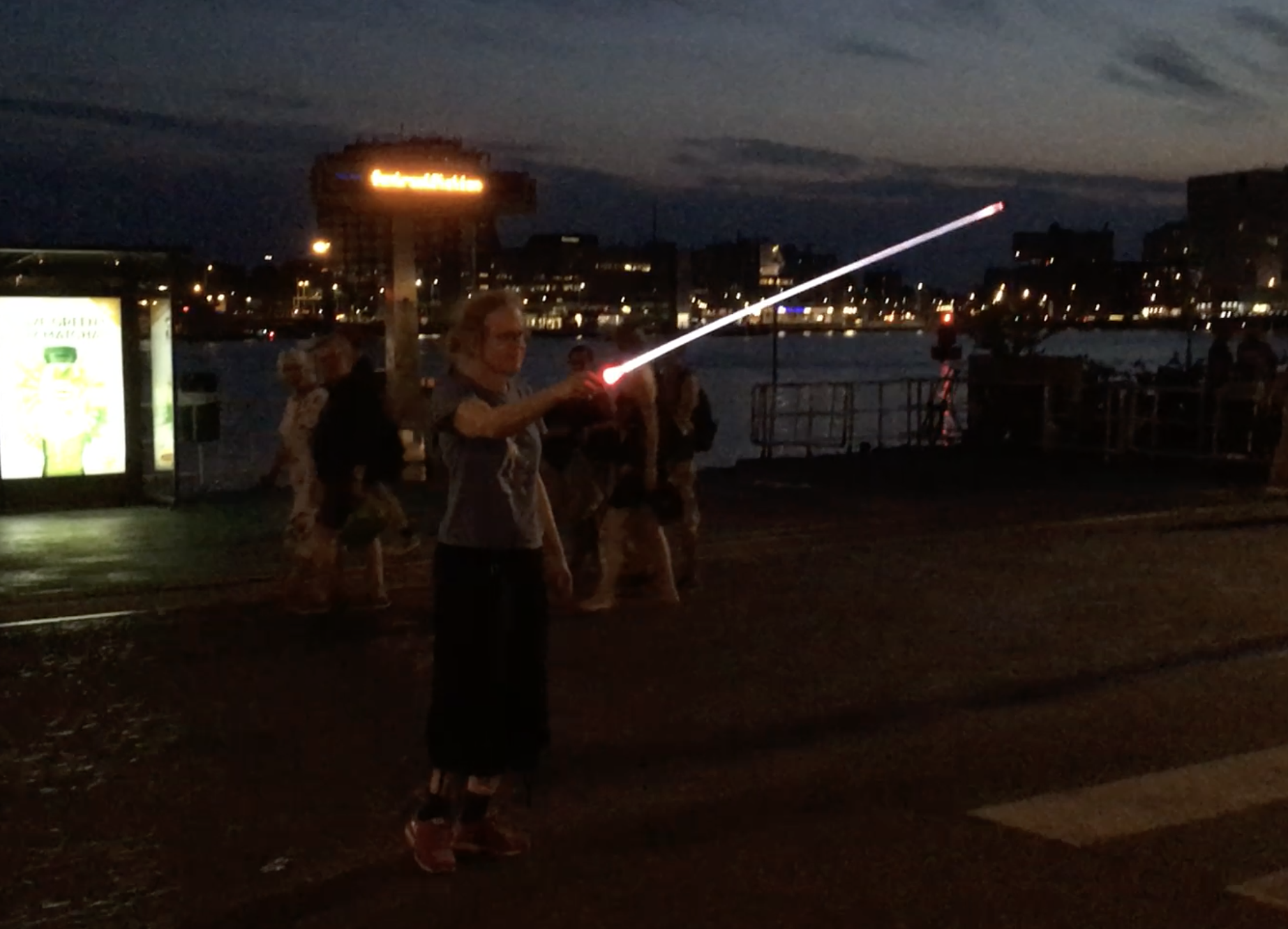
The FabLab in the Waag in Amsterdam
The FabLab van de Waag, on the Nieuwmarkt in Amsterdam, is filled with people who all want the best for mankind. Patient technicians, an inspiring director (always making technology accessible to ordinary citizens, including co-founder of De Digitale Stad), interns who (try to) develop the most fantastic products such as Open Source prostheses, which you can use with self-made 3D printers. manufacturing with plastic waste in a remote poor area without health care, etc. All people who want to contribute something good or beautiful to the well-being of the whole humanity, including themselves.
Good company, good antidepressant.
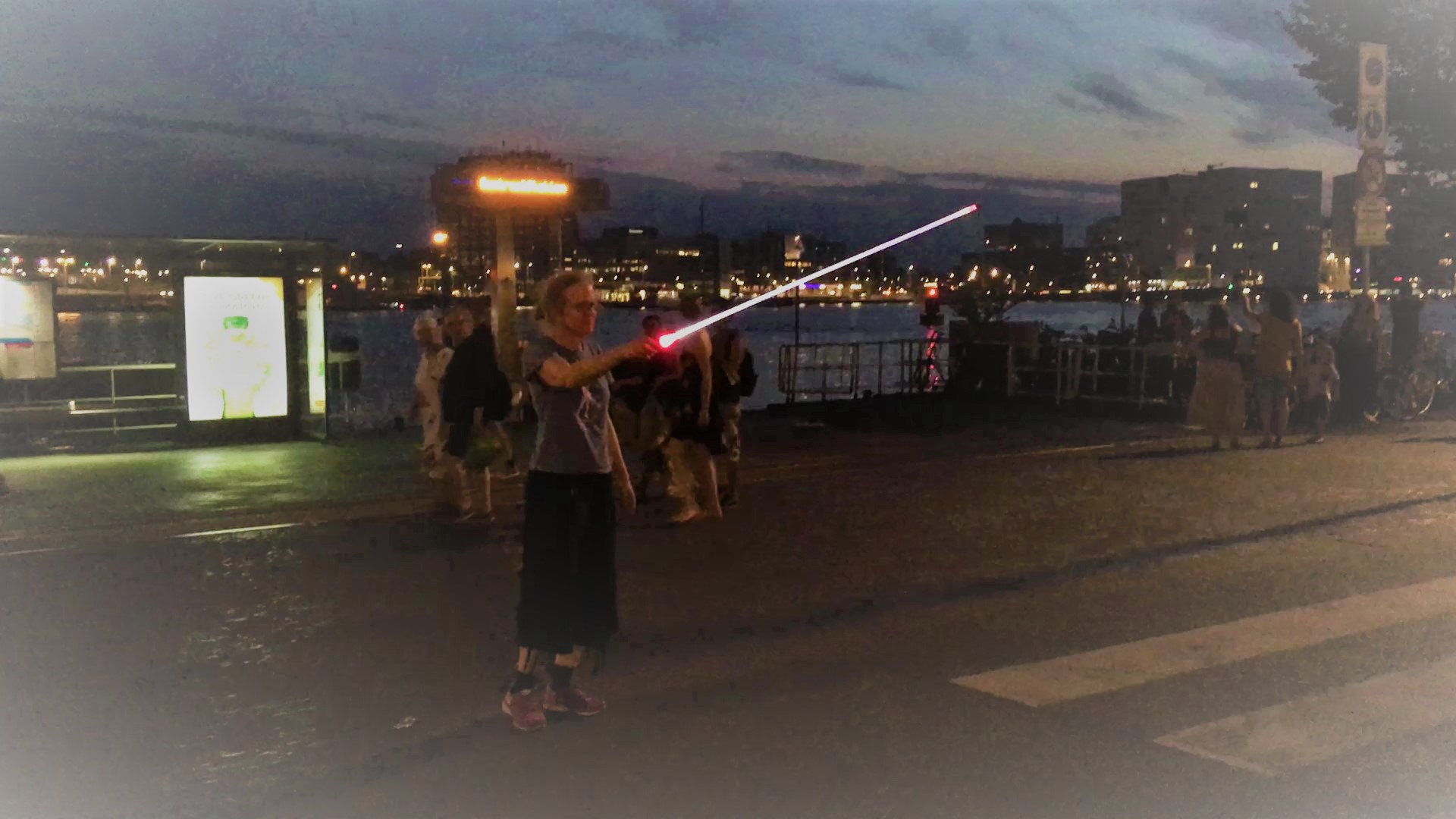
This website is aimed to enhance the lives of the Visually Impaired and Blind (VIB).